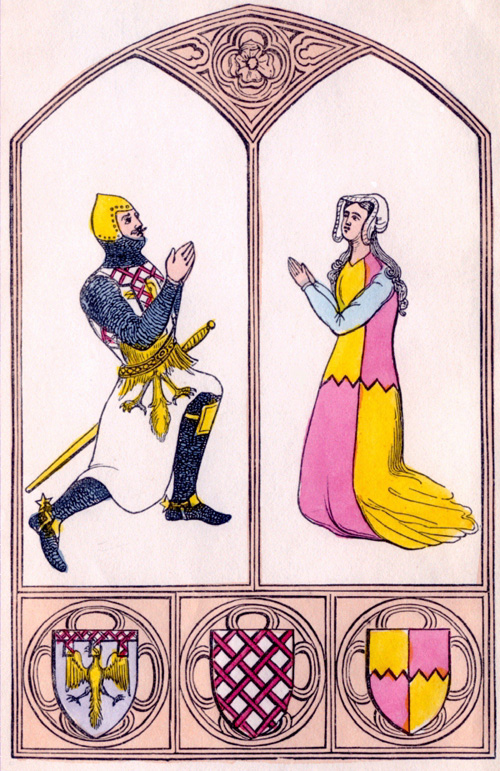
This eBook is for the use of anyone anywhere at no cost and with almost no restrictions whatsoever. You may copy it, give it away or re-use it under the terms of the Project Gutenberg License included with this eBook or online at www.gutenberg.org
Title: The Manual of Heraldry; Fifth Edition
Being a Concise Description of the Several Terms Used, and Containing a Dictionary of Every Designation in the Science
Author: Anonymous
Release Date: July 12, 2005 [eBook #16273]
Language: English
Character set encoding: ISO-8859-1
***START OF THE PROJECT GUTENBERG EBOOK THE MANUAL OF HERALDRY; FIFTH EDITION***
|
Transcriber's Note: The following changes have been made to inconsistent spelling in the original text: Chap. IV.: 'scarpe' for 'scrape'; and, in the dictionary: SEMÉ/semé for SEME/seme. |
|
CHAPTER I ORIGIN OF COATS OF ARMS. |
PAGE 1 |
|
CHAPTER II VARIOUS SORTS OF ARMS. |
4 |
|
CHAPTER III LINES USED IN PARTING THE FIELD. |
11 |
|
CHAPTER IV HONOURABLE ORDINARIES. |
17 |
|
CHAPTER V SUBORDINATE ORDINARIES. |
26 |
|
CHAPTER VI MARSHALLING CHARGES ON ESCUTCHEONS BY THE RULES OF HERALDRY. |
35 |
|
CHAPTER VII ORDER OF PRECEDENCY. |
44 |
|
DICTIONARY OF HERALDIC TERMS |
47 |
|
CHAPTER VIII HERALDRY IN CONNECTION WITH HISTORY, ARCHITECTURE, INTERIOR DECORATION, COSTUME, AMUSEMENT, RELIGIOUS SOLEMNITIES, FUNERAL RITES, ETC. |
127 |
Heraldry is the science which teaches how to blazon or describe in proper terms armorial bearings and their accessories.
Many volumes have been written on the origin of Heraldry and even on the antiquity of separate charges contained in an escutcheon: it would be filling the pages of an elementary work on Heraldry to little purpose to enter upon an inquiry as to the exact period of the introduction of an art that has existed in some degree in all countries whose inhabitants have emerged from barbarism to civilization. In all ages men have made use of figures of living creatures, trees, flowers, and inanimate objects, as symbolical signs to distinguish themselves in war, or denote the bravery and courage of their chief or nation.
The allegorical designs emblazoned on the standards, shields, and armour of the Greeks and Romans—the White Horse of the Saxons, the Raven of the Danes, and the Lion of the Normans, may all be termed [Page 2] heraldic devices; but according to the opinions of Camden, Spelman, and other high authorities, hereditary arms of families were first introduced at the commencement of the twelfth century. When numerous armies engaged in the expeditions to the Holy Land, consisting of the troops of twenty different nations, they were obliged to adopt some ensign or mark in order to marshal the vassals under the banners of the various leaders. The regulation of the symbols whereby the Sovereigns and Lords of Europe should be distinguished, all of whom were ardent in maintaining the honour of the several nations to which they belonged, was a matter of great nicety, and it was properly entrusted to the Heralds who invented signs of honour which could not be construed into offence, and made general regulations for their display on the banners and shields of the chiefs of the different nations. The ornaments and regulations were sanctioned by the sovereigns engaged in the Crusade, and hence the origin of the present system of Heraldry, which prevails with trifling variations in every kingdom of Europe.
The passion for military fame which prevailed at this period led to the introduction of mock battles, called Tournaments. Here the Knights appeared with the Heraldic honours conferred upon them for deeds of prowess in actual battle. All were emulous of such distinctions. The subordinate followers appeared with the distinctive arms of their Lord, with the addition of some mark denoting inferiority. These marks of honour at first were merely pieces of stuff of various colours cut into strips and sewn on the surcoat or garment worn over armour, to protect it from the effect of exposure to the atmosphere. These strips were disposed in various ways, and gave the idea of the chief, bend, chevron, &c. [Page 3] Figures of animals and other objects were gradually introduced; and as none could legally claim or use those honourable distinctions unless they were granted by the Kings of Arms, those Heraldic sovereigns formed a code of laws for the regulation of titles and insignia of honour, which the Sovereigns and Knights of Europe have bound themselves to protect; and those rules constitute the science of Heraldry which forms the subject of the following pages.
Arms are not only granted to individuals and families, but also to cities, corporate bodies, and learned societies. They may therefore be classed as follows:—
Arms of Dominion or Sovereignty are properly the arms of the kings or sovereigns of the territories they govern, which are also regarded as the arms of the State. Thus the Lions of England and the Russian Eagle are the arms of the Kings of England and the Emperors of Russia, and cannot properly be altered by a change of dynasty.
Arms of Pretension are those of kingdoms, provinces, or territories to which a prince or lord has some claim, and which he adds to his own, though the kingdoms or territories are governed by a foreign king or lord: thus the Kings of England for many ages quartered the arms of France in their escutcheon as the descendants of Edward III., who claimed that kingdom, in right of his mother, a French princess.
Arms of Concession are arms granted by sovereigns as the reward of virtue, valour, or extraordinary service. All arms granted to subjects were originally [Page 5] conceded by the Sovereign.
Arms of Community are those of bishoprics, cities, universities, academies, societies, and corporate bodies.
Arms of Patronage are such as governors of provinces, lords of manors, add to their family arms as a token of their superiority, right, and jurisdiction.
Arms of Family, or paternal arms, are such as are hereditary and belong to one particular family, which none others have a right to assume, nor can they do so without rendering themselves guilty of a breach of the laws of honour punishable by the Earl Marshal and the Kings at Arms. The assumption of arms has however become so common that little notice is taken of it at the present time.
Arms of Alliance are those gained by marriage.
Arms of Succession are such as are taken up by those who inherit certain estates by bequest, entail, or donation.
The Shield contains the field or ground whereon are represented the charges or figures that form a coat of arms. These were painted on the shield before they were placed on banners, standards, and coat armour; and wherever they appear at the present time they are painted on a plane or superficies resembling a shield.
Shields in Heraldic language are called Escutcheons
or Scutcheons, from the Latin word scutum. The forms
of the shield or field upon which arms are emblazoned
are varied according to the taste of the painter. The
Norman pointed shield is generally used in Heraldic
paintings in ecclesiastical [Page 6]

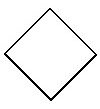 buildings: the escutcheons of maiden ladies and widows are
painted on a lozenge-shaped shield.
Armorists distinguish several
points in the escutcheon in order to determine exactly
the position of the bearings or charges. They are denoted
in the annexed diagram, by the first nine letters
of the alphabet ranged in the following manner:
buildings: the escutcheons of maiden ladies and widows are
painted on a lozenge-shaped shield.
Armorists distinguish several
points in the escutcheon in order to determine exactly
the position of the bearings or charges. They are denoted
in the annexed diagram, by the first nine letters
of the alphabet ranged in the following manner:
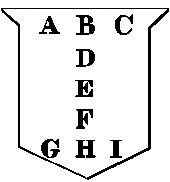 A, the dexter chief.
A, the dexter chief.
B, the precise middle chief.
C, the sinister chief.
D, the honour point.
E, the fess point.
F, the nombril point.
G, the dexter base.
H, the precise middle base.
I, the sinister base.
The dexter side of the escutcheon answers to the left hand, and the sinister side to the right hand of the person that looks at it.
By the term Tincture is meant that variable hue which is given to shields and their bearings; they are divided into colours and furs.
The colours or metals used in emblazoning arms are—
| yellow, white, red, |
blue, black, green, |
purple, orange, murrey. |
These colours are denoted in engravings by various lines or dots, as follows:
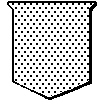 OR, which signifies gold, and in colour yellow, is expressed by dots.
OR, which signifies gold, and in colour yellow, is expressed by dots.
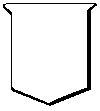 ARGENT signifies silver or white: it is left quite plain.
ARGENT signifies silver or white: it is left quite plain.
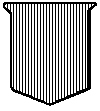 GULES signifies red: it is expressed by lines drawn from the chief to the base of the shield.
GULES signifies red: it is expressed by lines drawn from the chief to the base of the shield.
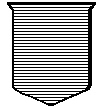 AZURE signifies blue: it is represented
by lines drawn from the dexter to
the sinister side of the shield, parallel
to the chief.
AZURE signifies blue: it is represented
by lines drawn from the dexter to
the sinister side of the shield, parallel
to the chief.
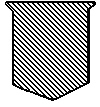 VERT signifies green: it is represented
by slanting lines, drawn from the
dexter to the sinister side of the
shield.
VERT signifies green: it is represented
by slanting lines, drawn from the
dexter to the sinister side of the
shield.
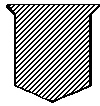 PURPURE, or purple, is expressed by
diagonal lines, drawn from the sinister
to the dexter side of the shield.
PURPURE, or purple, is expressed by
diagonal lines, drawn from the sinister
to the dexter side of the shield.
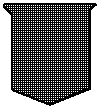 SABLE, or black, is expressed by horizontal
and perpendicular lines crossing
each other.
SABLE, or black, is expressed by horizontal
and perpendicular lines crossing
each other.
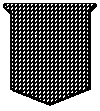 TENNE, which is tawny, or orange
colour, is marked by diagonal lines
drawn from the sinister to the dexter
side of the shield, traversed by perpendicular
lines from the chief.
TENNE, which is tawny, or orange
colour, is marked by diagonal lines
drawn from the sinister to the dexter
side of the shield, traversed by perpendicular
lines from the chief.
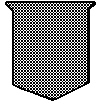 SANGUINE is dark red, or murrey colour;
it is represented by diagonal
lines crossing each other.
SANGUINE is dark red, or murrey colour;
it is represented by diagonal
lines crossing each other.
In addition to the foregoing tinctures, there are nine roundlets or balls used in Armory, the names of which are sufficient to denote their colour without expressing the same.
 |
BEZANT, Or. |  |
PLATE, Argent. |
 |
HURTS, [Page 9]Azure. |
 |
TORTEAUX, Gules. |
 |
GOLPE, Purpure. |
 |
PELLET, Sable. |
 |
ORANGE, Tenne. |
 |
GUZES, Sanguine. |
 |
POMEIS, Vert. |
Furs are used to ornament garments of state and denote dignity: ther are used in Heraldry, not only for the lining of mantles and other ornaments of the shield, but also as bearings on escutcheons.
WHITE, represented by a plain shield, like argent.
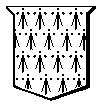 ERMINE—white powdered with black tufts.
ERMINE—white powdered with black tufts.
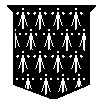 ERMINES—field sable, powdering argent.
ERMINES—field sable, powdering argent.
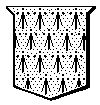 ERMINOIS—field or, powdering sable.
ERMINOIS—field or, powdering sable.
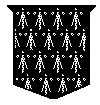 PEAN—field sable; powdering or.
PEAN—field sable; powdering or.
 ERMYNITES—Argent, powdered sable,
with the addition of a single red hair
on each side the sable tufts. This
fur is seldom seen in English heraldry;
and it is impossible to give
an example without using colour.
ERMYNITES—Argent, powdered sable,
with the addition of a single red hair
on each side the sable tufts. This
fur is seldom seen in English heraldry;
and it is impossible to give
an example without using colour.
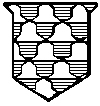 VAIR—argent and azure. It is represented
by small bells, part reversed,
ranged in lines in such a manner,
that the base argent is opposite to
the base azure.
VAIR—argent and azure. It is represented
by small bells, part reversed,
ranged in lines in such a manner,
that the base argent is opposite to
the base azure.
 COUNTER-VAIR, is when the bells
are placed base against base, and
point against point.
COUNTER-VAIR, is when the bells
are placed base against base, and
point against point.
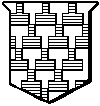 POTENT—an obsolete word for a crutch:
it is so called in Chaucer's description
of Old Age.
POTENT—an obsolete word for a crutch:
it is so called in Chaucer's description
of Old Age.
"So eld she was that she ne went
A foote, but it were by potent."
The field is filled with small potents, ranged in lines, azure and argent.
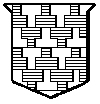 POTENT COUNTER-POTENT.
POTENT COUNTER-POTENT.
The heads
of the crutches or potents touch each
other in the centre of the shield.
Escutcheons that have more than one tincture are divided by lines; the straight lines are either perpendicular |, horizontal —, diagonal line dexter \, and diagonal line sinister /.
Curved and angular lines are numerous, and each has an Heraldic name expressive of its form. The names and figures of those most commonly used by English armorists are as follow:—
Engrailed
Invected
Wavy, or undé
Embattled, or crenelle
Nebule
Indented
Dancette
Angled
Bevilled
Escartelle
Nowy, or franché
Dove-tailed
Embattled grady:
sometimes called
battled embattled
Potent
Double arched
Arched or enarched
Urdée

Radient
If a shield is divided into four equal parts, it is said to be quartered: this may be done two ways, viz.—
 QUARTERED PER CROSS—The shield
is divided into four parts, called
quarters, by an horizontal and perpendicular
line, crossing each other
in the centre of the field, each of
which is numbered.
QUARTERED PER CROSS—The shield
is divided into four parts, called
quarters, by an horizontal and perpendicular
line, crossing each other
in the centre of the field, each of
which is numbered.
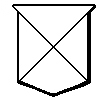 QUARTERED PER SALTIER,
which is made by two diagonal lines,
dexter and sinister, crossing each
other in the centre of the field.
QUARTERED PER SALTIER,
which is made by two diagonal lines,
dexter and sinister, crossing each
other in the centre of the field.
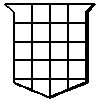 The Escutcheon is sometimes divided
into a great number of parts, in order
to place in it the arms of several
families to which one is allied; this
is called a genealogical achievement.
The compartments are called QUARTERINGS.
The Escutcheon is sometimes divided
into a great number of parts, in order
to place in it the arms of several
families to which one is allied; this
is called a genealogical achievement.
The compartments are called QUARTERINGS.
All members of the same family claim the same bearings in their coats of arms;
and to distinguish the principal bearer from his descendants or relatives, it was
necessary to invent some sign so that the degree of consanguinity might be known.
These signs are called DIFFERENCES. During the Crusades, the only difference
consisted in the bordure or border, which, as the name implies, was a border or edging
running round the edge of the shield. The colour and form of this border served to
distinguish the leaders of the different bands that served under one duke or chieftain.
The same difference might be used to denote a diversity between particular persons descended
from one family. At the present time they are not used to denote a difference, but as
one of the ordinaries to a coat of arms.
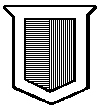 The annexed example exhibits the arms of the Monastery
of Bermondsey.
Party per pale, azure and gules; a bordure, argent.
This bordure is plain; but they may be formed by any of the foregoing lines.
The annexed example exhibits the arms of the Monastery
of Bermondsey.
Party per pale, azure and gules; a bordure, argent.
This bordure is plain; but they may be formed by any of the foregoing lines.
 The annexed example is or, a bordure engrailed, gules.
The annexed example is or, a bordure engrailed, gules.
The differences used by armorists at the present time are nine in number. They not only distinguish the sons of one family, but also denote the subordinate degrees in each house.
| The Heir, or first son, the LABEL | |
Second Son, the CRESCENT |

|
| Third Son, the MULLET | 
|
| Fourth Son, the MARTLET | 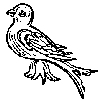
|
| Fifth Son, the ANNULET | 
|
| Sixth Son, the FLEUR-DE-LIS | 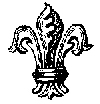
|
| Seventh Son, [Page 15]the ROSE | 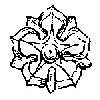
|
| Eighth Son, the CROSS MOLINE | 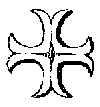
|
| Ninth Son, the DOUBLE QUATREFOIL | 
|
Should either of the nine brothers have male children, the eldest child would place the label on the difference that distinguished his father; the second son would place the crescent upon it; the third the mullet; continuing the same order for as many sons as he may have.
The label only, is used in the arms of the royal family as a difference; but the points of the label are charged with different figures to distinguish the second and succeeding sons. The arms of the sons of King George III. were thus distinguished: the shield of the arms of the Prince of Wales by a label; the Duke of York's by the label, the center point of which was charged with a red cross; that of the Duke of Clarence by a label, the dexter and sinister points of which were charged with an anchor, the center point with the red cross; each of the succeeding sons were differenced by charges on the points of the labels.
[Page 16]All the figures denoting differences are also used as perfect charges on the shield; but their size and situation will sufficiently determine whether the figure is used as a perfect coat of arms, or is introduced as a difference or dimunition.
Sisters have no differences in their coats of arms. They are permitted to bear the arms of their father, as the eldest son does after his father's decease.
Guillim, Leigh, and other ancient armorists mention divers figures, which, they assert, were formerly added to coats of arms as marks of degradation for slander, cowardice, murder, and other crimes, and to them they give the name of abatements of honour; others have called them blots in the escutcheon: but as no instance can be produced of such dishonourable marks having been borne in a coat of arms, they may justly be considered as chimerical, or at any rate obsolete, and unworthy of consideration at the present time. Porney pithily observes, "that arms being marks of honour, they cannot admit of any note of infamy, nor would any one bear them if they were so branded. It is true, a man may be degraded for divers crimes, particularly high treason; but in such cases the escutcheon is reversed, trod upon, and torn in pieces, to denote a total extinction and suppression of the honour and dignity of the person to whom it belonged."
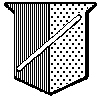 The only abatement used in heraldry is the baton: this denotes illegitimacy. It is borne in the
escutcheons of the dukes that assume the royal arms as the illegitimate descendants of King
Charles the Second.
The only abatement used in heraldry is the baton: this denotes illegitimacy. It is borne in the
escutcheons of the dukes that assume the royal arms as the illegitimate descendants of King
Charles the Second.
Honourable ordinaries are the original marks of distinction bestowed by sovereigns on subjects that have become eminent for their services, either in the council or the field of battle. Volumes have been written upon the origin and form of the honourable ordinaries. These long and tedious inquiries can only be interesting to antiquaries: it is sufficient for the tyro in heraldry to know that they are merely broad lines or bands of various colours, which have different names, according to the place they occupy in the shield; ancient armorists admit but nine honourable ordinaries—the chief, the pale, the bend, the bend sinister, the fess, the bar, the chevron, the cross, and the saltier.
The chief is an ordinary terminated by an horizontal line, which, if it is of any other form but straight, its form must be expressed; it is placed in the upper part of the escutcheon, and occupies one third of the field.

Ex. Argent, on a chief, gules, two mullets, sable.
Any of the lines before described may be used to form the chief.
[Page 18]
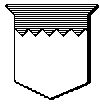 Ex. Argent, a chief, azure, indented.
Ex. Argent, a chief, azure, indented.
The chief has a diminutive called a fillet; it must never be more than one fourth the breadth of the chief.
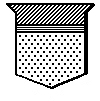 Ex. Or, a chief, purpure, in the lower
part a fillet, azure.
Ex. Or, a chief, purpure, in the lower
part a fillet, azure.
This ordinary may be charged with a variety of figures, which are always named after the tincture of the chief.
It may be necessary to inform the reader that, in describing a coat of arms, the general colour of the shield or the field is first described, then the honourable ordinaries, their tinctures, then the object with which they are charged. We shall have to remark more particularly on the order of describing ordinaries, tinctures, and charges on coats of arms, when we treat of the rules of heraldry; but the student might have been confused if this brief direction had been omitted, as we shall have to describe every shield of arms in the same order.
The pale is an honourable ordinary, consisting of two perpendicular lines drawn from the top to the base of the escutcheon, and contains one third of the width of the field.
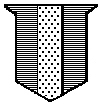 Ex. Azure, a pale, or.
Ex. Azure, a pale, or.
The pale may be formed of any of the lines before [Page 19] described; it is then called a pale engrailed, a pale dancette, &c.
The pale has a diminutive called the pallet, which is one half the width of the pale.
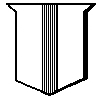 Ex. Argent, a pallet, gules.
Ex. Argent, a pallet, gules.
The pale has another diminutive one fourth its size; it is called an endorse.
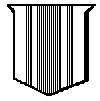 Ex. Argent, a pale between two endorses,
gules.
Ex. Argent, a pale between two endorses,
gules.
The pale and the pallet may receive any charge; but the endorse is never to be charged with any thing.
The bend is an honourable ordinary, formed by two diagonal lines drawn from the dexter chief to the sinister base, and contains the fifth part of the field if uncharged; but if charged with other figures, the third part of the field.
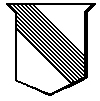 Ex. Argent, a bend, vert.
Ex. Argent, a bend, vert.
The bend has four diminutives, viz. the garter which [Page 20] is half the breadth of the bend.
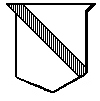 Ex. Argent, a garter, gules.
Ex. Argent, a garter, gules.
The cotice which is the fourth part of the bend. Cotices generally accompany the bend in pairs; thus a bend between two cotices is said to be cotised.
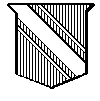 Ex. Gules, a bend, argent, coticed
of the same.
Ex. Gules, a bend, argent, coticed
of the same.
The riband, which is one third less than the garter and the bendlet, must never occupy more than one sixth of the field.
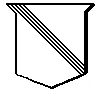 Ex. Argent, a riband vert.
Ex. Argent, a riband vert.
 Ex. Gules, two bendlets, engrailed,
argent.
Ex. Gules, two bendlets, engrailed,
argent.
The bend sinister is the same breadth as the bend dexter, and is drawn from the sinister to the dexter side of the shield.
[Page 21]
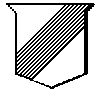 Ex. Argent, a bend sinister, purpure.
Ex. Argent, a bend sinister, purpure.
The scarpe is the diminutive of the bend sinister, and is half its size.
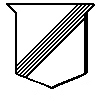 Ex. Argent, a scarpe, purpure.
Ex. Argent, a scarpe, purpure.
The baton is the fourth part of the bend, and, as before mentioned, it is a mark of illegitimacy, and seldom used in Heraldry, but by the illegitimate descendants of royalty.
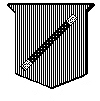 Ex. Gules, a baton, sable, garnished, or.
Ex. Gules, a baton, sable, garnished, or.
The fess is formed by two horizontal lines drawn above and below the centre of the shield. The fess contains in breadth one third of the field.
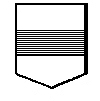 Ex. Argent, a fess, azure.
Ex. Argent, a fess, azure.
The bar is formed in the same manner as the fess, but it only occupies the fifth part of the field. It differs from the fess, that ordinary being always placed in the [Page 22] centre of the field; but the bar may be placed in any part of it, and there may be more than one bar in an escutcheon.
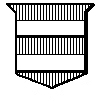 Ex. Gules, two bars, argent.
Ex. Gules, two bars, argent.
The closet is a diminutive of the bar, and is half its width.
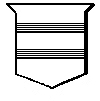 Ex. Argent, two closets, azure.
Ex. Argent, two closets, azure.
The barrulet is half the width of the closet.
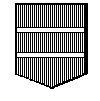 Ex. Gules, two barrulets, argent.
Ex. Gules, two barrulets, argent.
The annexed example is to illustrate the word gemels, which is frequently used to describe double bars. The word gemels is a corruption of the French word jumelles, which signifies double.
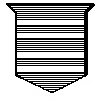 Ex. Azure, two bars, gemels, argent.
Ex. Azure, two bars, gemels, argent.
When the shield contains a number of bars of metal [Page 23] and colour alternate, exceeding five, it is called barry of so many pieces, expressing their numbers.
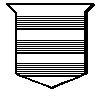 Ex. Barry of seven pieces, argent and azure.
Ex. Barry of seven pieces, argent and azure.
The figure of the chevron has been described as representing the gable of a roof. It is a very ancient ordinary, and the less it is charged with other figures the more ancient and honourable it appears.
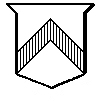 Ex. Argent, a chevron, gules.
Ex. Argent, a chevron, gules.
The diminutives of the chevron, according to English Heraldry, are the chevronel, which is half the breadth of the chevron.
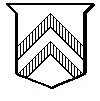 Ex. Argent, two chevronels, gules.
Ex. Argent, two chevronels, gules.
And the couple-close, which is half the chevronel.
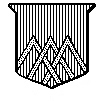 Ex. Gules, three couple-closes interlaced
in base, or.
Ex. Gules, three couple-closes interlaced
in base, or.
Braced is sometimes used for interlaced. See the word [Page 24] BRACED in the Dictionary.
This, as its name imports, was the distinguishing badge of the Crusaders, in its simplest form. It was merely two pieces of list or riband of the same length, crossing each other at right angles. The colour of the riband or list denoted the nation to which the Crusader belonged. The cross is an honourable ordinary, occupying one fifth of the shield when not charged, but if charged, one third.
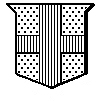 Ex. Or, a cross, gules.
Ex. Or, a cross, gules.
When the cross became the distinguishing badge of different leaders in the Crusades, the simple form given in the preceding example was not generally adopted. Some bordered the red list with a narrow white edge, others terminated the arms of the cross with short pieces of the same colour, placed transversely, making each arm of the cross have the appearance of a short crutch; the ends of these crutches meeting in a point, make the cross potent. There is so great a variety of crosses used in Heraldry that it would be impossible to describe them within the limits of this introduction to Heraldry. The reader will find a great number of those most used in English Heraldry described and illustrated in the Dictionary. He of course will understand, if a coat of arms comes under his notice where this ordinary is described as a cross engrailed, a cross invected, [Page 25] that the form of the cross is the same as that in the last example, but that the lines forming it are engrailed, invected, &c. Small crosses borne as charges are called crosslets.
See the words CROSS, CROSSLETS, in the Dictionary.
The saltier was formed by making two pieces of riband cross diagonally, having the appearance of the letter X, or, speaking heraldically, the bend and bend sinister crossing each other in the centre of the shield. The saltier, if uncharged, occupies one-fifth of the field; if charged, one-third.
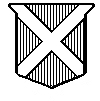 Ex. Gules, a saltier, argent.
Ex. Gules, a saltier, argent.
Like the cross, the saltier may be borne engrailed, wavy, and the termination of the arms of the saltier varied; but there are not so many examples of the variation of the form in the saltier as in the cross.
In order more particularly to distinguish the subordinates in an army (the chieftains of different countries alone being entitled to the preceding marks of honour), other figures were invented by ancient armorists, and by them termed subordinate ordinaries. Their names and forms are as follows:—
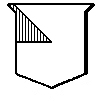 The gyron is a triangular figure formed
by drawing a line from the dexter
angle of the chief of the shield to the
fess point, and an horizontal line
from that point to the dexter side of
the shield.
The gyron is a triangular figure formed
by drawing a line from the dexter
angle of the chief of the shield to the
fess point, and an horizontal line
from that point to the dexter side of
the shield.
The field is said to be gyrony when it is covered with gyrons.
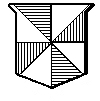 Ex. Gyrony of eight pieces, argent and
gules.
Ex. Gyrony of eight pieces, argent and
gules.
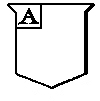 The canton is a square part of the escutcheon,
usually occupying about one-eighth
of the field; it is placed over the
chief at the dexter side of the shield:
it may be charged, and when this is the
case, its size may be increased. The
canton represents the banner of the ancient Knights [Page 27]
Banneret. The canton in the example is marked A.
The canton is a square part of the escutcheon,
usually occupying about one-eighth
of the field; it is placed over the
chief at the dexter side of the shield:
it may be charged, and when this is the
case, its size may be increased. The
canton represents the banner of the ancient Knights [Page 27]
Banneret. The canton in the example is marked A.
See KNIGHTS BANNERET in the Dictionary.
The lozenge is formed by four equal and parallel lines but not rectangular, two of its opposite angles being acute, and two obtuse.
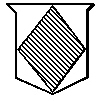 Ex. Argent, a lozenge, vert.
Ex. Argent, a lozenge, vert.
The fusil is narrower than the lozenge, the angles at the chief and base being more acute, and the others more obtuse.
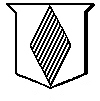 Ex. Argent, a fusil, purpure.
Ex. Argent, a fusil, purpure.
The mascle is in the shape of a lozenge but perforated through its whole extent except a narrow border.
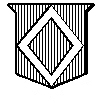 Ex. Gules, a mascle, argent.
Ex. Gules, a mascle, argent.
The fret is formed by two lines interlaced in saltier with a mascle.
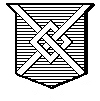 Ex. Azure, a fret, argent.
Ex. Azure, a fret, argent.
Fretty is when the shield is covered with lines[Page 28] crossing each other diagonally and interlaced.
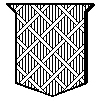 Ex. Gules, fretty of ten pieces, argent.
Ex. Gules, fretty of ten pieces, argent.
At the present time it is not usual to name the number of pieces, but merely the word fretty.
The pile is formed like a wedge, and may be borne wavy, engrailed, &c.; it issues generally from the chief, and extends towards the base, but it may be borne in bend or issue from the base.
See PILE and IN PILE in Dictionary.
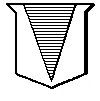 Ex. Argent, a pile, azure.
Ex. Argent, a pile, azure.
The inescutcheon is a small escutcheon borne within the shield.
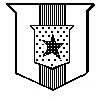 Ex. Argent, a pale, gules, over all an
inescutcheon or, a mullet sable.
Ex. Argent, a pale, gules, over all an
inescutcheon or, a mullet sable.
An orle is a perforated inescutcheon, and usually takes the shape of the shield whereon it is placed.
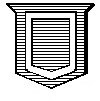 Ex. Azure, an orle, argent.
Ex. Azure, an orle, argent.
The flanche is formed by two curved lines nearly [Page 29] touching each other in the centre of the shield.
 Ex. Azure, a flanche, argent.
Ex. Azure, a flanche, argent.
In the flasque the curved lines do not approach so near each other.
 Ex. Azure, a flasque, argent.
Ex. Azure, a flasque, argent.
In the voider the lines are still wider apart; this ordinary occupies nearly the whole of the field: it may be charged.
 Ex. Azure, a voider, argent.
Ex. Azure, a voider, argent.
The tressure is a border at some distance from the edge of the field, half the breadth of an orle: the tressure may be double or treble.
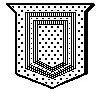 Ex. Or, a double tressure, gules.
Ex. Or, a double tressure, gules.
Tressures are generally ornamented, or borne flory or [Page 30] counter flory as in the annexed example.
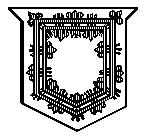 Ex. Argent, a double tressure, flory
and counter-flory, gules.
Ex. Argent, a double tressure, flory
and counter-flory, gules.
At first when the Feudal System prevailed, not only in England, but other parts of Europe, none but military chieftains bore Coats of Arms. And as few persons held land under the Crown but by military tenure, that is, under the obligation of attending in person with a certain number of vassals and retainers when their services were required by the king for the defence of the state, heraldic honours were confined to the nobility, who were the great landholders of the kingdom. When they granted any portion of their territory to their knights and followers as rewards for deeds of prowess in the field or other services, the new possessors of the land retained the arms of their patrons with a slight difference to denote their subordinate degree. The ingenuity of the armorist was not then taxed to find a multitude of devices to distinguish every family. And when chivalry became the prevailing pursuit of all that sought honour and distinction by deeds of arms and gallant courtesy, the knights assumed the privilege that warriors in all ages have used; viz. that of choosing any device they pleased to ornament the crests of their helmets in the field of battle, or in the mock combat of the tournament: the knight was known and named from the device used as his crest. Thus the heralds, in introducing him to the judges of the field, or to the lady that bestowed [Page 31] the prizes, called him the Knight of the Swan, the Knight of the Lion, without mentioning any other title. And knights whose fame for gallantry and prowess was firmly established, had their crests painted over their coats of arms. In two or three generations the bearer of the arms established his right to a new crest, and the heralds, to preserve the memory of the ancient honour of the family, introduced the old crest into the coat of arms, either as a charge upon the principal ordinary, or on an unoccupied part of the field. This will in some measure account for the variety of animals and parts of animals found in shields of arms. When the sovereigns of Europe, to decrease the power of the great barons, bestowed estates and titles not only for deeds of arms, but wisdom in council, superior learning, and other qualities which the original bearers of arms thought beneath their notice, the heralds were obliged to invent new symbols in emblazoning the arms of the modern nobility; and when arms were granted to civic and commercial corporations, and to private individuals who had no claim to military honours, we can easily conceive that the ingenuity of the armorists was severely tested, and excuse the apparent confusion that prevailed in granting arms after the War of the Roses. Sir William Dugdale, in his treatise entitled "Ancient Usage in bearing Arms", states that, "Many errors have been and are still committed in granting coats of arms to such persons as have not advanced themselves by the sword, being such as rise by their judgment or skill in arts, affairs, and trades"; with good reason affirming that the latter should however only be allowed "notes or marks of honour fit for their calling, and to show forth the manner of their rising, and not be set off with those representations which in their nature are only proper for martial [Page 32] men."
It would be utterly impossible to give either a graphic or written description of all the charges in a book of this size or even in one ten times as large. The sun, moon, stars, comets, meteors, have been introduced to denote glory, grandeur, power, &c.; lions, leopards, tigers, serpents, stags, have been employed to signify courage, strength, prudence, swiftness, &c.
The application to certain exercises, such as war, hunting, music, fishing, has furnished lances, swords, armour, musical instruments, architecture, columns, chevrons, builders' tools, &c. Human bodies, or distinct parts of them, are frequently used as charges. Trees, plants, fruits, and flowers have also been admitted to denote the rarities, advantages, and singularities of different countries.
The relation of some creatures, figures, &c. to particular names has been a fruitful source for variety of arms. Thus, the family of Coningsby bears three conies; of Arundel, six swallows; of Corbet, a raven; of Urson, a bear; of Camel, a camel; of Starky, a stork; of Castleman, a castle triple-towered; of Shuttleworth, three weaver's shuttles. Hundreds of other names might be given, but the before-mentioned will be sufficient to show the reader the origin of many singular charges in coats of arms.
Not only were natural and artificial figures used, but the lack of information on Zoology and other branches of Natural History led to the introduction of fabulous animals, such as dragons, griffins, harpies, wiverns, &c. A great number of charges, indeed most of them that require explanation, will be found in the Dictionary of Heraldic Terms, which will prevent the necessity of describing them more at large in this part of the book.
[Page 33]The ornaments that accompany or surround escutcheons were introduced to denote the birth, dignity, or office of the person to whom the coat of arms belongs. We shall merely give the names of the various objects in this place, and refer the reader to the different words in the Dictionary. Over regal escutcheons are placed the crown which pertains to the nation over which the sovereign presides. The crown is generally surmounted with a crest: as in the arms of the kings of England, the crown is surmounted by a lion statant, guardant, crowned.
Over the Papal arms is placed a tiara or triple crown, without a crest.
Above the arms of archbishops and bishops the mitre is placed instead of a crest.
Coronets are worn by all princes and peers. They vary in form according to the rank of the nobleman. A full description will be found in the Dictionary of the coronets of the prince of Wales, royal dukes, dukes, marquises, earls, viscounts, and barons.
Helmets are placed over arms, and show the rank of the person to whom the arms belong: 1st, by the metal of which they are made; 2dly, by their form; 3dly, by their position. See the word HELMET in the Dictionary.
Mantlings were the ancient coverings of helmets to preserve them and the bearers from the injuries of the weather. It is probable that they were highly ornamented with scroll-work of gold and silver, and their borders or edges cast into fanciful shapes. They are now formed into scroll-work proceeding from the sides of the helmet, and are great ornaments to an escutcheon. See a more full description under the word MANTLING.
[Page 34]A chapeau is an ancient hat or rather cap of dignity worn by dukes. They were formed of scarlet velvet and turned up with fur. They are frequently used instead of a wreath under the crests of noblemen and even gentlemen.
The wreath was formed by two large skeins of silk of different colours twisted together. This was worn at the lower part of the crest, not alone as an ornament, but to protect the head from the blow of a mace or sword. In Heraldry the wreath appears like a straight line or roll of two colours generally the same as the tinctures of the shield. The crest is usually placed upon the wreath.
The crest is the highest part among the ornaments of a coat of arms. It is called crest from the Latin word crista, which signifies comb or tuft.
Crests were used as marks of honour long before the introduction of Heraldry. The helmets and crests of the Greek and Trojan warriors are beautifully described by Homer. The German heralds pay great attention to crests, and depict them as towering to a great height above the helmet. Knights who were desirous of concealing their rank, or wished particularly to distinguish themselves either in the battle field or tourney, frequently decorated their helmets with plants or flowers, chimerical figures, animals, &c.; these badges were also assumed by their descendants. The difference between crests and badges as heraldic ornaments is, that the former are always placed on a wreath, in the latter they are attached to the helmet. The scroll is a label or ribbon containing the motto: it is usually placed beneath the shield and supporters; see the word MOTTO in the Dictionary.
The symbolic figures of Heraldry are so well known to those acquainted with the science in every kingdom of Europe, that if an Englishman was to send a written emblazonment or description of an escutcheon to a French, German, or Spanish artist acquainted with the English language, either of them could return a properly drawn and coloured escutcheon; but a correct emblazonment would be indispensable. A single word omitted would spoil the shield.
The reader has already been informed that in emblazoning an escutcheon, the colour of the field is first named; then the principal ordinary, such as the fess, the chevron, &c., naming the tincture and form of the ordinary; then proceed to describe the charges on the field, naming their situation, metal, or colour; lastly, describe the charges on the ordinary.
When an honourable ordinary or some one figure is placed upon another, whether it be a fess, chevron, cross, &c., it is always to be named after the ordinary or figure over which it is placed, with either the words surtout or overall.
[Page 36]In the blazoning such ordinaries as are plain, the bare mention of them is sufficient; but if an ordinary should be formed of any of the curved or angular lines, such as invected, indented, &c., the lines must be named.
When a principal figure possesses the centre of the field, its position is not to be expressed; it is always understood to be in the middle of the shield.
When the situation of a principal bearing is not expressed, it is always understood to occupy the centre of the field. Ex. See Azure, an annulet argent, p. 48.
The number of the points of mullets must be specified if more than five: also if a mullet or any other charge is pierced, it must be mentioned.
When a ray of the sun or other single figure is borne in any other part of the escutcheon than the centre, the point it issues from must be named.
The natural colour of trees, plants, fruits, birds, &c., is to be expressed in emblazoning by the word proper; but if they vary from their natural colour, the tincture or metals that is used must be named.
Two metals cannot come in contact: thus or, cannot be placed on argent, but must be contrasted with a tincture.
[Page 37]When there are many figures of the same species borne in coats of arms, their number must be observed as they stand, and properly expressed. The annexed arrangements of roundlets in shields will show how they are placed and described.
 The two roundlets are arranged in
pale, but they may appear in chief
or base; or in fess, as in No. 2.
The two roundlets are arranged in
pale, but they may appear in chief
or base; or in fess, as in No. 2.

 Three roundlets, two over one; if the
single roundlet had been at the top,
it would have been called one over
two.
Three roundlets, two over one; if the
single roundlet had been at the top,
it would have been called one over
two.
 Three roundlets in bend. They might
also be placed in fess, chief, base,
or in pale.
Three roundlets in bend. They might
also be placed in fess, chief, base,
or in pale.
 Four roundlets, two over two. Some
armorists call them cantoned as they
form a square figure.
Four roundlets, two over two. Some
armorists call them cantoned as they
form a square figure.
 Five roundlets; two, one, two, in
saltier.
Five roundlets; two, one, two, in
saltier.
 Five roundlets; one, three, one, or in
cross.
Five roundlets; one, three, one, or in
cross.
 Six roundlets; two, two, two, paleway.
Six roundlets; two, two, two, paleway.
 Six roundlets; three, two, one, in
pile.
Six roundlets; three, two, one, in
pile.
There are seldom more figures than seven, but no matter the number; they are placed in the same way, commencing with the figures at the top of the shield, or in chief. If the field was strewed all over with roundlets, this would be expressed by the word semé.
Marshalling coats of arms, is the act of disposing the arms of several persons in one escutcheon, so that their relation to each other may be clearly marked.
In Heraldry, the husband and wife are called baron and femme; and when they are descended from distinct families, both their arms are placed in the same escutcheon, divided by a perpendicular line through [Page 39] the centre of the shield. As this line runs in the same direction, and occupies part of the space in the shield appropriated to the ordinary called the pale, the shield is in heraldic language said to be parted per pale. The arms of the baron (the husband) are always placed on the dexter side of the escutcheon; and the femme (the wife), on the sinister side, as in the annexed example.
 Parted per pale, baron and femme,
two coats; first, or, a chevron gules;
second, barry of twelve pieces, azure
and argent.
Parted per pale, baron and femme,
two coats; first, or, a chevron gules;
second, barry of twelve pieces, azure
and argent.
If a widower marries again, the arms of both his wives are placed on the sinister side, which is parted per fess; that is, parted by an horizontal line running in the direction of the fess, and occupying the same place. The arms of the first wife are placed in the upper compartment of the shield, called the chief; the arms of the second wife in the lower compartment, called the base.
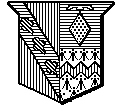 Parted per pale, baron and femme,
three coats;—first, gules, on a bend
azure, three trefoils vert: second,
parted per fess, in chief azure, a
mascle or, with a label argent for difference.
In base ermine, a fess,
dancette gules. The same rule would apply if the husband
had three or more wives; they would all be placed
in the sinister division of the shield.
Parted per pale, baron and femme,
three coats;—first, gules, on a bend
azure, three trefoils vert: second,
parted per fess, in chief azure, a
mascle or, with a label argent for difference.
In base ermine, a fess,
dancette gules. The same rule would apply if the husband
had three or more wives; they would all be placed
in the sinister division of the shield.
Where the baron marries an heiress, he does not impale his arms with hers, as in the preceding examples, but bears them in an escutcheon of pretence in the centre of the shield, showing his pretension to her lands [Page 40] in consequence of his marriage with the lady who is legally entitled to them. The escutcheon of pretence is not used by the children of such marriage; they bear the arms of their father and mother quarterly, and so transmit them to posterity. Annexed is an example of the arms of the femme on escutcheon of pretence.
 Baron and femme, two coats; first,
gules, a saltier argent; second, on
an escutcheon of pretence, azure, a
chevron, or.
Baron and femme, two coats; first,
gules, a saltier argent; second, on
an escutcheon of pretence, azure, a
chevron, or.
If a peeress in her own right, or the daughter of a peer, marries a private gentleman, their coats of arms are not conjoined paleways, as baron and femme, but are placed upon separate shields by the side of each other; they are usually inclosed in a mantel, the shield of the baron occupying the dexter side of the mantel, that of the femme the sinister; each party has a right to all the ornaments incidental to their rank. The femme claiming the arms of her father, has a right to his supporters and coronet. The baron, who only ranks as an esquire, has no right to supporters or coronet, but exhibits the proper helmet, wreath, and crest.
The peeress, by marrying one beneath her in rank, confers no dignity on her husband, but loses none of her own. She is still addressed as "your ladyship," though her husband only ranks as a gentleman; and it is for this reason that the arms cannot be conjoined in one shield as baron and femme.
Ex. Baron and femme, two atchievements. First, azure, a pile or, crest a star of six points, argent; second, gules, a cross flory argent, surmounted by an earl's coronet: supporters, on the dexter side a stag ducally gorged and chained, on the sinister side a [Page 41] griffin gorged and chained; motto, Honour and Truth.
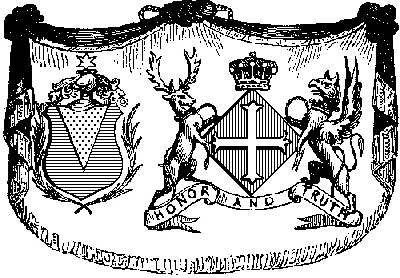
In the arms of the femme joined to the paternal coat of the baron, the proper differences by which they were borne by the father of the lady must be inserted.
If the arms of the baron has a bordure, that must be omitted on the sinister side of the shield.
Archbishops and bishops impale the paternal arms with the arms of the see over which they preside, placing the arms of the bishopric on the dexter, and their paternal arms on the sinister side of the shield; a bishop does not emblazon the arms of his wife on the same shield with that which contains the arms of the see, but on a separate shield.
Arms of augmentation are marshalled according to the direction of the College of Heralds: they are usually placed on a canton in the dexter chief of the shield; in some cases they occupy the whole of the chief. The mark of distinction denoting a baronet is usually placed on an escutcheon, on the fess point of the shield.
The rules here laid down apply to funeral atchievements, banners, &c. The only difference, as will be [Page 42] seen by the annexed examples, is, that the ground of the hatchment is black, that surrounds the arms of the deceased, whether baron or femme, and white round the arms of the survivor.
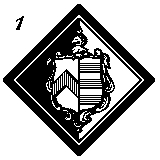 In fig. 1. the black is left on the
dexter side, showing that the
husband is deceased, and that his
wife survives him.
In fig. 1. the black is left on the
dexter side, showing that the
husband is deceased, and that his
wife survives him.
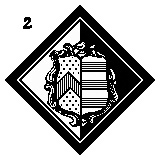 Fig. 2. shows that the husband survives
the wife.
Fig. 2. shows that the husband survives
the wife.
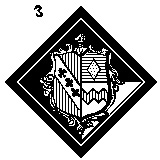 Fig. 3. shows that the husband and
his first wife are deceased, and
that the second wife is the survivor.
Fig. 3. shows that the husband and
his first wife are deceased, and
that the second wife is the survivor.
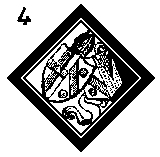 Fig. 4. The shield on the dexter
side of the hatchment is parted
per pale; first, the arms of the
bishopric; second, the paternal
arms of the bishop. The shield
on the dexter side is the arms of
the bishop impaling those of his
wife as baron and femme; the
ground of the hatchment is black round the sinister [Page 43]
side of this shield, showing that it is the wife that is
dead.
Fig. 4. The shield on the dexter
side of the hatchment is parted
per pale; first, the arms of the
bishopric; second, the paternal
arms of the bishop. The shield
on the dexter side is the arms of
the bishop impaling those of his
wife as baron and femme; the
ground of the hatchment is black round the sinister [Page 43]
side of this shield, showing that it is the wife that is
dead.
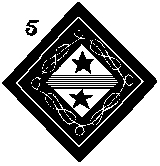 Fig. 5. is the hatchment of a lady
that has died unmarried. The
arms of females of all ranks are
placed in a lozenge-shaped shield.
Fig. 5. is the hatchment of a lady
that has died unmarried. The
arms of females of all ranks are
placed in a lozenge-shaped shield.
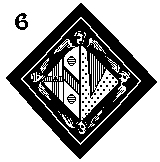 Fig. 6. is the hatchment of the
widow of a bishop; the arms are
the same as those displayed at
fig. 4.: here the lozenge-shaped
shield is parted per pale. Baron
and femme:—first, parted paleways,
on the dexter side the arms of
the bishopric, on the sinister side
the paternal arms of the bishop. Second, the arms of
the femme: the widow of a bishop has a right to exhibit
the arms of the see over which her husband presided,
as though his death has dissolved all connection
with the see. She has a right to emblazon all that will
honour her deceased husband.
Fig. 6. is the hatchment of the
widow of a bishop; the arms are
the same as those displayed at
fig. 4.: here the lozenge-shaped
shield is parted per pale. Baron
and femme:—first, parted paleways,
on the dexter side the arms of
the bishopric, on the sinister side
the paternal arms of the bishop. Second, the arms of
the femme: the widow of a bishop has a right to exhibit
the arms of the see over which her husband presided,
as though his death has dissolved all connection
with the see. She has a right to emblazon all that will
honour her deceased husband.
For banners, pennons, guidons, cyphers, hatchments, &c., and all other matters where heraldic emblazonment is used in funeral processions, the reader is referred to the Dictionary.
The order of precedency to be observed in England was settled by an act of parliament passed in the thirty-first year of the reign of Henry VIII. The order has been varied at different periods to accord with the alterations in the families of the reigning monarchs, and the creation of new offices. The following table shows the order of precedency at the present time, viz. the eighth year of the reign of Queen Victoria.
The following dignitaries precede all Dukes, except those of the blood royal:—
The following dignitaries precede all of their own [Page 45] degree:—
The Lords Spiritual of Ireland rank next after the Lords Spiritual of Great Britain; the priority of signing any treaty or public instrument by the members of the government is always taken by rank of place, not by title.
The style prefixed to the titles of the peerage of Great Britain and Ireland are as follows :—
ABAISSÉ. A French word, generally used in heraldry instead of the English word abased. When the fess, or any other ordinary properly placed above the fess point of the shield, is brought below it, that ordinary is said to be abaissé.
ABATEMENT. Any figure added to coats of arms tending to lower the dignity or station of the bearer. Thus, the baton, denoting illegitimacy, is an abatement: so, also, are the differences in coats of arms showing the degrees of consanguinity.
ADDORSED. Any animals set back to back. See LION.
ALLERION. An eagle displayed, without beak or feet.

Ex. Argent, an allerion gules.
ALTERNATE. Figures or tinctures that succeed each other by turns.
AMETHYST. A precious stone of a violet colour, the name of which was formerly used instead of purpure, to denote the purple tincture when emblazoning the arms of the English nobility.
ANNULET. A small circle borne as a charge in coats of [Page 48] arms.

Ex. Azure, an annulet argent. Annulets are added to arms for a difference. See DIFFERENCES, p. 13.
ANCIENT. A small flag or ensign. The bearer of the flag was called by its name. Iago was ancient to the troops commanded by Othello.
"This is Othello's ancient, as I take it.
The same indeed, a very valiant fellow." SHAKSPEARE.
ARCHBISHOPS. Church dignitaries of the first class. There are but two in England—the Archbishop of Canterbury and the Archbishop of York. The former is the first peer of England next to the royal family, and has the title of Grace given to him; and likewise Most Reverend Father in God. He is styled Primate of all England, and Metropolitan.
The Archbishop of York has precedence of dukes and great officers of state, except the lord chancellor. He is called His Grace and Most Reverend Father in God; and styled Primate of England and Metropolitan.
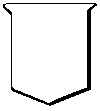
ARGENT. The French word for silver, of which metal all white fields or charges are supposed to consist.
ARMED. This word is used to express the horns, hoofs, beak, or talons of any beast or bird of prey, when borne of a different tincture from those of their bodies.
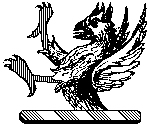
Ex. Crest, a demi-griffin armed, gules.
[Page 49] ARMORIST. A person skilled in the bearings of coats of arms, and all relating to their emblazonment.
ARMS. A word derived from the Latin arma, which signifies in Heraldry a mark of honour, serving to distinguish states, cities, families, &c.
ARROWS. Short darts feathered at the ends.
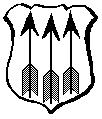
Ex. Argent, three arrows paleways, points in chief sable, feathered.
ASPECTANT. Animals placed face to face in a charge are said to be aspectant. If they are about to attack each other, they are said to be combatant.
ASSUMPTIVE. Arms assumed without being sanctioned by a grant from the College of Heralds.
ASSURGENT. A man or beast rising out of the sea is said to be assurgent.
ATCHIEVEMENT. The coat of arms fully emblazoned according to the rules of Heraldry. The lozenge-shaped atchievements that are displayed on the outside of the houses of persons deceased are commonly called Hatchments.
ATTIRED. When the horns of a stag are of a different tincture to its head, it is said to be attired.
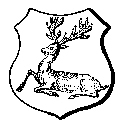
Ex. Argent, a stag lodged, proper, attired, or
AUGMENTATION. This word signifies in Heraldry a particular mark of honour, granted by the sovereign in consideration of some noble action, or by favour; and either quartered with the family arms, or on an [Page 50] escutcheon or canton.
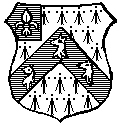
Ex. Ermine, on a chevron azure, three foxes' heads erased, argent. The augmentation is in a canton azure, a fleur-de-lis argent.
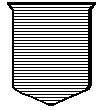
AZURE. The French word for blue: it is distinguished in heraldic engraving by lines running parallel to each other in an horizontal direction, as in the annexed example.
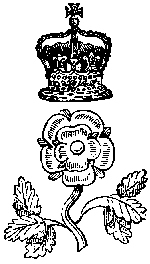
BADGE. A distinctive mark worn by servants, retainers, and followers of royalty or nobility, who, being beneath the rank of gentlemen, have no right to armorial bearings. The rose and crown is the badge of the servants, &c., of the Kings of England: they are displayed as in the annexed example.
BANDED. Anything tied with a band.
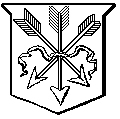
Ex. Argent. Three arrows proper, banded.
BANNER. The principal standard of a knight. The great banner borne at the funeral of a nobleman contains all the quarterings of his arms: it varies in size according to the rank of the deceased. The banner of the sovereign is five feet square; that of a prince or duke, four feet square; for all noblemen of inferior rank, three feet square.
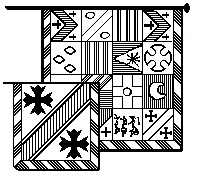
BANNER ROLL is a small square flag containing a single escutcheon of the deceased. Thus, if there are twelve quarterings in the banner, the same number of banner rolls will be required to be borne in the funeral procession. The annexed engraving shows the banner and banner-roll.
BAR. An honourable ordinary, occupying one-fifth of the shield. It may be placed in any part of the field. It has two diminutives, the closet and barrulet.
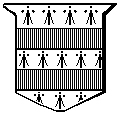
Ex. Ermine, two bars gules.
BARBED. Bearded. It is also applied to roses.
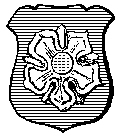
Ex. Azure, a rose argent, barbed, and seeded proper.
BARON. The lowest title of the peerage of Great Britain.
BARON AND FEMME. Terms used in Heraldry to denote [Page 52] the arms of a man and his wife, marshalled together. See p. 38.
BARRULET. The smallest diminutive of the bar. The closet is half the bar; the barrulet half the closet.
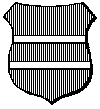
Ex. Gules, two barrulets argent.
BARRY. A field divided transversely into several equal parts, and consisting of two different tinctures interchangeably disposed.
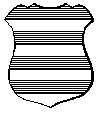
Ex. Barry of eight pieces, azure and argent.
BATON. BATUNE. BASTON. It is generally used as an abatement in coats of arms to denote illegitimacy.
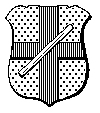
Ex. Or, a cross gules, over all a baton argent.
BATTERING RAM. An instrument used for battering down walls before gunpowder was known in Europe: it is frequently borne as a charge in a coat of arms.
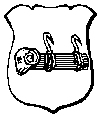
Ex. Argent, a battering ram proper.
BATTLE AXE. An ancient military weapon, frequently borne on arms as a mark of prowess.
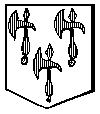
Ex. Argent, three battle axes gules two over one.
BATTLEMENTS. Divisions or apertures on the top of castle walls or towers.
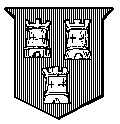
Ex. Gules, three towers embattled argent.
BEAKED. The beak of a bird being of a different tint from the body is said to be beaked.
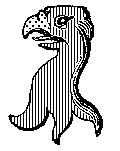
Ex. An eagle's head erased, beaked, or.
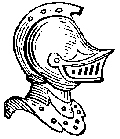
BEAVER. That part of the helmet that defends the sight.
BELLED. Having bells.
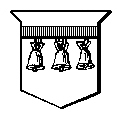
Ex. Argent, a barrulet gules, belled with three bells proper.
BEND. One of the honourable ordinaries formed by [Page 54] two diagonal lines drawn from the dexter chief to the sinister base; it generally occupies a fifth part of the shield if uncharged, but if charged one third.
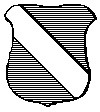
Ex. Azure, a bend argent.
BEND SINISTER. Is the reverse of the bend; it is seldom found in coats of arms, as it is reckoned an abatement.
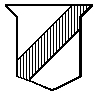
Ex. Argent, a bend sinister gules.
IN BEND. Figures placed in a slanting direction from the dexter chief to the sinister base are said to be in bend.
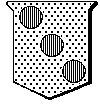
Ex. Or, three torteaux in bend.
BENDLET. A diminutive of the bend, of the same shape, but only half the width of the bend.
BENDY. This word serves to denote a field divided diagonally into several bends, varying in metal and colour.
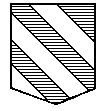
Ex. Bendy of six pieces, azure and argent.

BESANT, or BEZANT. Gold coin of Byzantium; when they appear in a coat of arms their colour is not described: a besant is always or.
BILLETS. This charge is, by some authors, supposed to represent tiles or bricks; by others that it represents a letter or billet. The name and form of the charge most accords with the latter opinion.
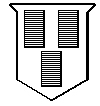
Ex. Argent, three billets azure, two over one.
BISHOPS. Church dignitaries: they are barons of the realm, and have precedence next to viscounts: they have the title of lords, and right reverend fathers in God.
BLAZON. To describe in proper colours, or lines representing colours, all that belongs to coats of arms. Arms may also be emblazoned by describing the charges and tinctures of a coat of arms in heraldic terms.
BLUE-MANTEL. A title of one of the pursuivants at arms. See HERALD.
BORDURE or BORDER. This was the most ancient difference in coats of arms, to distinguish different branches of the same family. It is a border round the edge of the shield. Its situation is always the same; but the inner edge may be varied.
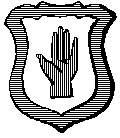
Ex. Argent, a sinister hand couped at the wrist and erected gules, within a bordure azure.
BOTTONNY. See CROSS BOTTONNY.
BOUJET. An ancient water bucket, frequently borne in shields of arms.
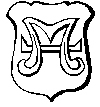
Ex. Argent, a boujet proper.
BRACED. Two figures of the same form, interlacing each other.

Ex. Vert, two triangles braced, argent.
BRASED and BRAZED are words sometimes used by ancient armorists. They always describe things interlaced or braced together.
BROAD ARROW. An ancient weapon of war, thrown by an engine. It is frequently borne as a charge in coats of arms.
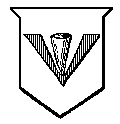
Ex. Argent, a broad arrow gules.
CABOCHED or CABOSHED. Beasts' heads borne without any part of the neck, and full faced.
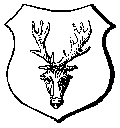
Ex. Argent, a stag's head caboshed, proper.
CALTROP. An iron instrument made to annoy an enemy's cavalry. They were formed of iron, being four spikes conjoined in such a manner that one was always upwards. It is found in many ancient coats of arms.
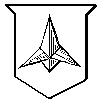
Ex. Argent, a caltrop proper.
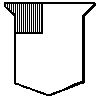
CANTON. The French word for corner. It is a small square figure, generally placed at the dexter chief of the shield, as in the annexed example.
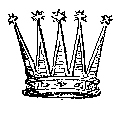
CELESTIAL CROWN. Distinguished from any other crown by the stars on the points or rays that proceed from the circlet.

CHAPEAU. Cap of maintenance or dignity, borne only by sovereign princes. It is formed of crimson or scarlet velvet, lined with ermine.
CHAPLET. An ancient ornament for the head, granted to gallant knights for acts of courtesy. It is frequently borne as a charge in a shield of arms, and always tinted in its natural colours.
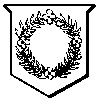
Ex. Argent, a chaplet proper.
CHARGE. The figures or bearings contained in an escutcheon.
CHECKY. The field covered with alternate squares of metal and fur.
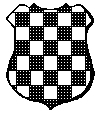
Ex. Checky, sable and argent.
CHEVRON. This ordinary is supposed to represent the rafters of the gable of a house.
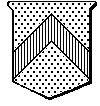
Ex. Or, a chevron gules.
CHEVRONEL. The diminutive of the chevron, being one half its size.
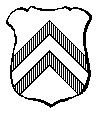
Ex. Argent, two chevronels gules.
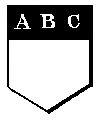
CHIEF. One of the honourable ordinaries. It is placed on the upper part of the shield and contains a third part of it. The letters show the points in the chief. A is the dexter chief; B, the precise middle chief; C, the sinister chief.
CHIMERICAL FIGURES. Imaginary figures, such as griffins, dragons, harpies, &c.: all of them will be found under their proper names.
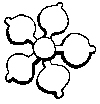
CINQUE FOIL. Five leaves conjoined in the centre.

CIVIC CAP. A cap of dignity borne by mayors of cities or corporate bodies: it is formed of sables garnished with ermine.
CLARION. A horn or trumpet borne in this shape in English and German coat-armour.
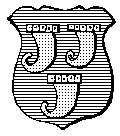
Ex. Azure, three clarions or.
CLENCHED. The fingers pressed towards the palm of the hand.
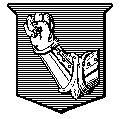
Ex. Azure, a dexter arm vambraced couped, the fist clenched proper.
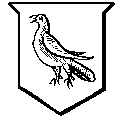
CLOSE. A bird with its wings closed.
CLOSET.. A diminutive of the bar, being only one half its width.
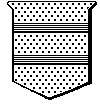
Ex. Or, two closets azure. [Page 60]
CLOSEGIRT. A figure whose dress is fastened round the waist.
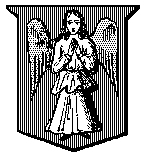
Ex. Gules, an angel erect with wings expanded or, dress closegirt.
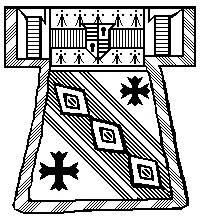
COAT ARMOUR, or Surcoat. A loose garment worn over the armour of a knight; hence the term coat of arms. On this garment were emblazoned the armorial bearings of the wearer.
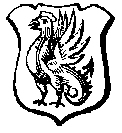
COCKATRICE. A chimerical animal, a cock with a dragon's tail and wings.
COLLARED. Having a collar. Dogs and inferior animals are sometimes collared: the supporters and charges are generally said to be gorged. See GORGED.
COMBATANT. A French word for fighting. See LION.
COMPLEMENT. The Heraldic term for the full moon. When this figure is introduced as a charge in a coat of arms, it is called a moon in her complement.
COMPONY. A term applied to a bordure, pale, bend, [Page 61] or any other ordinary, made up of squares of alternate metal and colour.
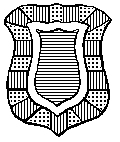
Ex. Argent, an inescutcheon azure, border compony, or and gules.
CONJOINED. Joined together.
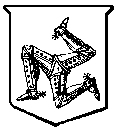
Ex. Argent, three legs armed, conjoined at the fess point at the upper extremity of the thigh, flexed in a triangle, garnished and spurred, or.

CONY. An heraldic name for a young rabbit.
COTICE. One of the diminutives of the bend: cotices are generally borne on each side of the bend.
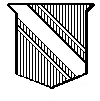
Ex. Gules, a bend argent, coticed of the same.
The cotices are frequently of a different tincture from the bend they cotice.
COUCHANT. The French word for lying down with the breast towards the earth, and the head raised. See LION COUCHANT.
COUNT. A nobleman that was deputed by the king to govern a county or shire: the title is not used in the British Peerage; his rank is equal to an earl.
[Page 62]COUNTER. In Heraldry implies contrariety, as in the following examples:—
COUNTER-CHANGED. The intermixture of metal with colours opposed to each other.
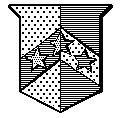
Ex. Per pale, or and azure, on a chevron, three mullets all counter-changed.
COUNTER SALIENT. Two animals leaping different ways from each other.
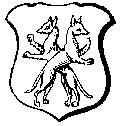
Ex. Argent, two foxes counter salient.
COUNTER PASSANT. Two animals passing the contrary way to each other.
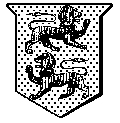
Ex. Or, two lions passant counter passant gules, the uppermost facing the sinister side of the escutcheon, both collared sable, garnished argent.
COUNTER FLORY. Any ordinary ornamented with fleurs-de-luce: the points of the flowers run alternately in a contrary direction.
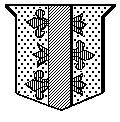
Ex. Or, a pale purpure, flory and counter flory gules.
COUPED. From the French word couper, to cut. The [Page 63] cross in the example is couped, part of it being cut off, so as not to touch the edges of the shield.
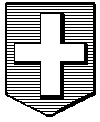
Ex. Azure, a cross couped argent.
COUPED. The head or limbs of any animal cut close is called couped.
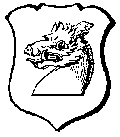
Ex. Argent, a boar's head proper couped.
COUPLE-CLOSE. One of the diminutives of the chevron, half the size of the chevronel.
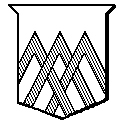
Ex. Argent, three couple-closes interlaced vert.
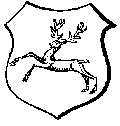
Ex. Argent, a stag proper courant.
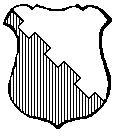
CRENELLE. The French heraldic term for embattled. See EMBATTLED.
CRESCENT. The half moon with its horns turned [Page 64] upwards.
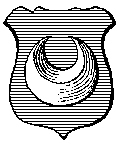
Ex. Azure, a crescent argent.
CREST. The ornament on the upper part of the helmet in Heraldry placed over coats of arms, either with or without the helmet. By referring to the title-page of this work the crests of Great Britain will be found with all the adornments of regal helmets.
The English crest is a crown surmounted by a lion statant guardant crowned, or.
The Scottish crest is an imperial crown, surmounted by a lion sejant guardant, displaying two sceptres or.
The Irish crest is an ancient diadem surmounted by an embattled tower, a stag courant issuing from the portal.
The crest of Wales is a dragon passant guardant, gules.—The whole of these crests, with mantlings, &c., are emblazoned on the title-page of this Manual.
Crests are usually displayed upon a wreath as in
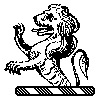 the annexed example, which is a demi-lion
rampant. If a crest this size had
been placed upon an helmet of proportionate
size it must have occupied a sixth
part of this page, and the shield containing
the arms to be in proportion considerably
larger: in showing the crest without the helmet
proportion is of little consequence. See HELMET,
WREATH, and MANTLING.
the annexed example, which is a demi-lion
rampant. If a crest this size had
been placed upon an helmet of proportionate
size it must have occupied a sixth
part of this page, and the shield containing
the arms to be in proportion considerably
larger: in showing the crest without the helmet
proportion is of little consequence. See HELMET,
WREATH, and MANTLING.
CRESTED. A cock or other bird, whose comb is of a different tincture from the body, is said to be crested. See JOWLOPED.
CRINED. This is said of an animal whose hair is of a different tincture from its body.
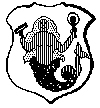
Ex. Argent, a mermaid gules, crined or.
CROSIER. The pastoral staff of a bishop or abbot: a very frequent charge in ecclesiastical arms.
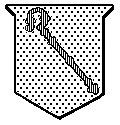
Ex. Or, a crosier gules, in bend.
CROSS. An honourable ordinary, more used as a charge in a coat of arms than any of the others. During the Crusades for the recovery of the Holy Land, the troops of the different nations that joined in the Crusade displayed crosses on their banners and arms: every soldier bore a cross upon his dress; this was composed of two pieces of list or riband of equal length, crossing each other at right angles. The soldiers of France attached their national emblem, the fleur-de-lis, to the ends of the members of the cross; hence the introduction of the cross flory. The Crusaders from the Papal dominions placed transverse pieces on each member of the plain cross, and by this means transformed it into four small crosses springing from a centre, forming what is now called the cross-crosslet. It would be impossible within the limits of this work to give an example of all the [Page 66] crosses that have been introduced as bearings in coats of arms. Berry, in his comprehensive work on Heraldry, gives nearly two hundred examples, without giving all that might be found. The following are the crosses most used in English Heraldry.
| Cross |  |
Cross potent |  |
| Cross flory |  |
Cross crosslet |  |
| Cross bottonny | 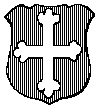 |
Cross pattee | 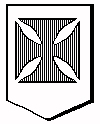 |
| Cross raguly | 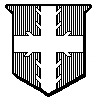 |
Cross patonce | 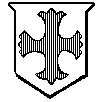 |
| Cross moline | 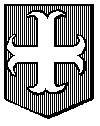 |
Cross quadrate | 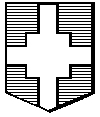 |
| Cross quarter-pierced | 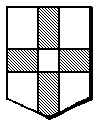 |
Cross of Calvary | 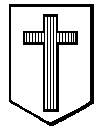 |
| Cross fitchy | 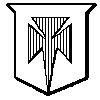 |
Cross patriarchal | 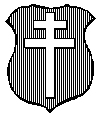 |
| Cross potent rebated |  |
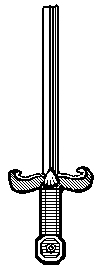
CURTANA. The pointless sword of mercy is the principal in dignity of the three swords that are borne naked before the British monarchs at their coronation.
| The crown of the king of England. | 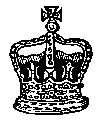 |
Coronet of the prince of Wales | 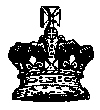 |
| Of a princess of England |  |
Of a marquis |  |
| Of a royal duke |  |
Of an earl |  |
| Of a duke |  |
Of a viscount |  |
| Coronet of a baron |  |
DANCETTE. A zig-zag figure with spaces between the points, much larger than in the indented.
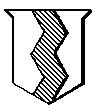
Ex. Argent, a pale, dancette vert.
DEBRUISED. Any animal that has an ordinary placed upon it is said to be debruised.
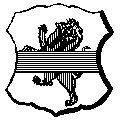
Ex. Argent, a lion rampant guardant gules, debruised by a fess azure.
DECRESSANT, or DECRESCENT. A moon in its wane, whose horns are turned to the sinister side of the escutcheon.
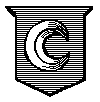
Ex. Azure, a moon decrescent, proper.
DEMI, or DEMY. This particle is always joined to a substantive, and signifies half; as, a demi-lion, i.e. half a lion.
DETRIMENT. The moon is said to be in its detriment when it is eclipsed.
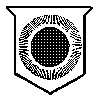
Ex. Argent, the moon in her detriment sable.
DEXTER. A word used in Heraldry to signify the right side of any thing.

DIADEM, a circle of gold with points rising from it, worn by ancient kings as the token of royalty. The diadem of most of the monarchs of Europe, as represented in ancient statuary, stained glass, and paintings, resembles the annexed engraving; the kings of England, from the Conquest to Henry VII., all wore a diadem of this shape.
DIAMOND. The hardest and most valuable of precious stones; it was formerly used by English heralds to denote black or sable in blazoning the arms of the nobility.
DIFFERENCE. The term given to a certain figure added [Page 70] to coats of arms to distinguish one family from another, and to show how distant younger branches are from the elder or principal branch. See p. 13.
DIMINUTION. A word sometimes used instead of difference.
DISPLAYED. A bird whose wings are expanded and legs spread is said to be displayed.
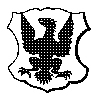
Ex. Argent, an eagle displayed sable.
DORMANT. The French word for sleeping, used to denote the posture of a lion, or any other beast reposing. See LION.
DOUBLINGS. The lining of robes of state, as also the rows of fur set on the mantles of peers.
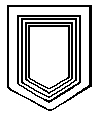
DOUBLE TRESSURE. Two Tressures, or orles, one within the other.
DOVETAILED. A term borrowed from carpentry to show tinctures joined together by reversed wedges, which, being shaped like doves' tails, are by joiners called dovetailing.
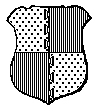
Ex. Quarterly per pale dove-tailed, or and gules.
DRAGON.. An imaginary monster; a mixture of beast, [Page 71] bird, and reptile. It is frequently borne in crests and charges.
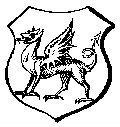
Ex. Argent, a dragon proper, tail nowed.
DRAGON'S HEAD. Part of a celestial constellation, used by ancient English heralds to denote tenne when emblazoning the arms of sovereigns; this style of heraldry has become obsolete.
DRAGON'S TAIL. Part of the same constellation; formerly used to denote sanguine.
DUKE. The highest degree of British peerage next to the prince of Wales. This title is derived from the Latin word dux: the title of Duke was known in other parts of Europe long before it was introduced into England. The first person that was created a duke in this country was Edward the Black Prince, who was created duke of Cornwall by his father Edward the third. The title has since that time belonged to the first born son of the monarch of England. A duke formerly possessed great authority over the province that formed his dukedom, and had large estates annexed to his title to support its dignity. At the present time dukes are created by patent, and their dukedom is merely nominal, neither power nor possessions being annexed to the title.
EAGLE. Aquila in Ornithology. In Heraldry the eagle is accounted one of the most noble bearings, and ought to be given only to such as greatly excel in the virtues of generosity and courage, or for having done some singular service to their sovereign.
EAGLET is a diminutive of eagle, properly signifying a [Page 72] young eagle. In Heraldry, when several eagles are on the same escutcheon, they are termed eaglets.
EARL. The third degree of British peerage. Under the Danish and Saxon kings this was the highest title known in England conferred upon a subject. It was formerly the custom upon creating an earl to assign him, for the support of his state, the third penny from the fines and profits of the sheriff's court, issuing out of the pleas of the shire whence the earl took his title; as, formerly, there was no count or earl but had a county or shire for his earldom. When the number of earls was increased, they took their titles from towns and villages. An earl is now created by patent.
EARL-MARSHAL OF ENGLAND. A very ancient, and formerly a very important, officer, who had several courts under his jurisdiction, as the Court of Chivalry, the Court of Honour. He still presides over the Heralds' College, and nominally over the Marshalsea Court. The title of Earl Marshal of England is now, and has been for some ages, hereditary in the noble family of the Howards.
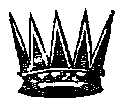
EASTERN CROWN. A crown with rays proceeding from a circle, called by heralds an Eastern crown, is found in ancient achievements. The annexed cut shows its form.
EMBATTLED. A line, formed like the battlements on a wall or tower, is said to be embattled or crenelle. When the line is used to form one of the ordinaries, it is said to be embattled. See the lines, p. 11.
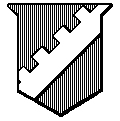
Ex. Gules, a bend sinister embattled, [Page 73] argent.
EMBATTLED GRADY. Where the battlements gradually rise one above another.
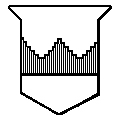
Ex. Argent, a fess gules, embattled grady. See the lines p. 11.
EMBOWED. Any thing bent or curved, like a bow.
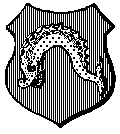
Ex. Gules, a dolphin naiant embowed or.
EMERALD. The name of a precious stone formerly substituted for vert in emblazoning the arms of the nobility of England.
EN ARRIÈRE. An expression borrowed from the French, to signify any creature borne with its back to view.
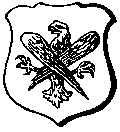
Ex. Argent, an eagle proper en arrière.
ENDORSE. The smallest diminutive of the pale.
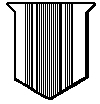
Ex. Argent, a pale between endorses [Page 74] gules.
ENGRAILED. Any object being edged with small semi-circles, the points turning outwards, is said to be engrailed.

Ex. Argent, a pale azure engrailed.
ENHANCED. A term applied to bearings placed above their usual situation.
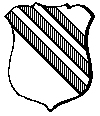
Ex. Argent, three bendlets, enhanced gules.
ENSIGNED. This word, in heraldic description, means ornamented.
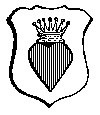
Ex. Argent, a man's heart gules, ensigned with a celestial crown or.
ERASED. Signifies any thing torn or plucked off from the part to which nature affixed it; generally applied to the head and limbs of man or beast.
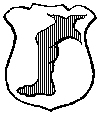
Ex. Argent, a leg erased at the [Page 75] midst of the thigh gules.
ERECT. This is said of any animal or parts of animals, naturally horizontal, being placed in a perpendicular direction.
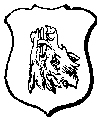
Ex. Argent, a boar's head erect, and erased.
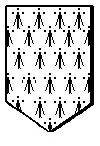
ERMINE. A white fur with black spots, represented as in the annexed example.
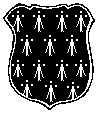
ERMINES. This fur is represented by white spots on a black field.
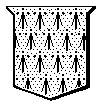
ERMINOIS. A fur, the field, or, the spots or tufts, sable, as in the annexed example.
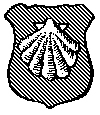
ESCALOP. The shell of a sea-fish, used to decorate the palmers on their way to and from Palestine; frequently used as a charge in Heraldry.
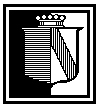
ESCUTCHEON. This word is sometimes used to express the whole coat of arms, sometimes only the field upon which the arms are painted. It more generally denotes the painted shields used at funerals. The field, if the husband is dead and wife survives, is black on the dexter side only; if the wife is deceased, it is black on the sinister side; if both, it is black all over. The example shows that this is the escutcheon of a deceased baron, whose lady survives.
ESCUTCHEON OF PRETENCE. A small escutcheon, on
which a man bears the coat of arms of his wife,
being an heiress.
See p. 40.
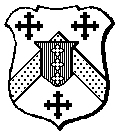
Ex. Argent, a chevron or, between three crosslets sable, on the fess point surtout the chevron an escutcheon of pretence gules, three quatrefoils argent.
ESQUIRE. The degree below a knight and above a gentleman. Those to whom this title is due by right, are all the younger sons of noblemen and their heirs male for ever, the four esquires of the king's body, the eldest sons of baronets, of all knights and of their heirs male: those who bear superior offices, as magistrates, high sheriffs, mayors, and aldermen, have it during their continuance in office and no [Page 77] longer. For the helmet of an esquire, see page 84.
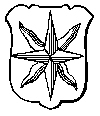
ETOILE. The French word for a star. It differs from the mullet in the number of points, and four of the points being rayant.
FESS. An honourable ordinary occupying the third part of the shield between the centre and the base.

Ex. Argent, a fess gules.

FESS POINT. The exact centre of the escutcheon, as seen in the annexed example. See the escutcheon lettered at p. 6., where this point is marked with the letter E.
FIELD. The whole surface of the shield or escutcheon: it is the ground upon which the colours, tinctures, furs, ordinaries, and charges, are represented.
FIGURED. Those bearings which are depicted with a human face, are said to be figured.

Ex. Gules, three bezants figured.
FILLET. The only diminutive belonging to the chief; its width is one-fourth of the chief, and is always placed at the base of it. See CHIEF, p. 18.
FIMBRIATED. An ordinary having a border of a different [Page 78] tincture is said to be fimbriated.
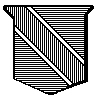
Ex. Azure, a bend gules, fimbriated argent.
FITCHY. Is from the French word fiché, fixed. It is generally applied to crosses which have their lower branch pointed, so that it could be fixed in the ground. See CROSS FITCHY.
FLANCHES. Are formed of two curved lines placed opposite each other.
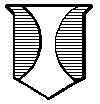
Ex. Azure, a flanche argent.
FLANK. That part of an escutcheon between the chief and the base.

Ex. Argent, three mullets gules, accompanied with seven cross crosslets fitchy sable—three in chief, one in fess, two in flanks, one in base.
FLASQUES. A subordinate ordinary formed by curved lines placed opposite each other, but not so near as in flanches.
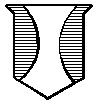
Ex. Azure, a flasque argent.
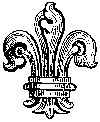
FLEUR-DE-LIS. Supposed to represent the garden-lily. It is the bearing of the Bourbons of France, but is frequently introduced in English charges.
FLORY. Signifies flowered or adorned with the fleur-de-lis. See FLORY COUNTER-FLORY, and CROSS-FLORY.
FRET. Two laths interlaced with a mascle.
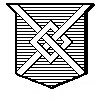
Ex. Azure, a fret argent.
FRETTY. This word denotes a field covered with fretwork or laths interlacing each other.
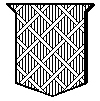
Ex. Gules, fretty argent.
THE FUSIL. Is longer than the lozenge: the upper and lower ends are more acute.
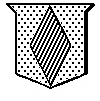
Ex. Or, a fusil purpure.
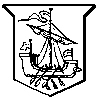
GALLEY. An ancient vessel propelled by oars; frequently used in shields of naval officers.
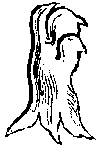
GAMBE. An obsolete French word, signifying a leg, and is still used in Heraldry, for the leg of a lion or other creature borne in coats of arms.
GARBE. The heraldic term for a sheaf of any kind of corn.
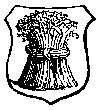
Ex. Argent, a garbe proper.
GARTER. One of the diminutives of the bend, being half the size.

Ex. Or, a garter vert.

GARTER. The insignia of the most noble order of the knights of the garter. It is formed of blue velvet edged with gold wire, and lined with white satin; on the velvet is embroidered the motto of the order. See KNIGHT.

GAUNTLET. Armour for the hand.
GAZE. An intent look. This is said of a deer standing still, and turning its head to look earnestly at any object.
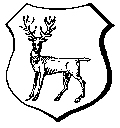
Ex. Argent, a stag at gaze proper.

GEMELS. This word signifies double. The example contains two double bars, which in heraldic language would be called two bars gemels.

GOLPS. Roundlets of a purple tincture. The colour is not stated, as the name denotes the colour.
GORGED. Any animals, particularly birds, that have collars round the neck, are said to be gorged.
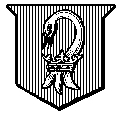
Ex. A swan's head erased at the neck, ducally gorged or.
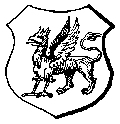
GRIFFIN or GRYPHON. A chimerical animal, half bird, half beast.

GUIDON. A small semi-oval flag used in funeral processions. It is generally charged with the paternal arms of the deceased.
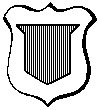
GULES. Signifies red. It is represented in engraving by lines running parallel with each other, from the chief to the base, as in the example.
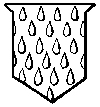
GUTTY. A term derived from the Latin word gutta, a drop. A field bearing drops, as in the example, is called gutty.
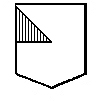
GYRON. A triangular figure formed by two lines from one of the angles of the shield to the centre. The gyron may be drawn in any part of the shield, but it is generally placed as in the annexed example.
GYRONNY. When the field is covered with gyrons, their points uniting in the centre.
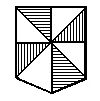
Ex. Gyronny of eight pieces, azure, argent, and gules.
HABERGEON. A coat of mail: it is also called a corslet and cuirass.
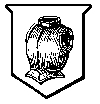
Ex. Argent, an habergeon proper.
HABITED. Clothed figures, either as charges or supporters, are said to be habited.
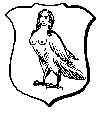
HARPY. A chimerical animal, having the head and breast of a woman, and the body and legs of a bird.
HAURIENT. A fish, in a perpendicular direction, with its head upwards.
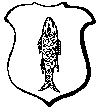
Ex. Argent, a salmon proper haurient.
HELMET. An ancient piece of defensive armour for the head; it covered the face, leaving an aperture in the front, secured by bars: this was called the visor. The helmet is now placed over a coat of arms; and by the metal from which it is made, the form, and position, denotes the rank of the person whose arms are emblazoned beneath it.
The helmets of sovereigns are formed of burnished gold; those of princes and peers, of every degree, silver figured with gold; knights, esquires, and gentlemen, [Page 84] polished steel.
The helmets of the king, the royal family, and peers, are open-faced and grated: the number of bars served formerly to distinguish the bearer's quality. The helmets of knights are open-faced, without bars. Esquires and gentlemen are known by the close helmet.
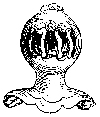
The position of the helmet is a mark of distinction. The direct front view of the grated helmet belongs to sovereign princes and dukes.
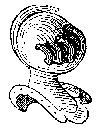
The grated helmet in profile is common to all degrees of peerage under a duke.
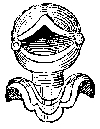
The helmet without bars, with the beaver open, standing directly fronting the spectator, denotes a knight.
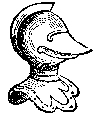
The closed helmet seen in profile is
appropriated to esquires and gentlemen.
See CREST, BEAVER, MANTLING.
HERALD. An officer at arms, whose business it is to [Page 85] declare war, proclaim peace, marshal all the solemnities at the coronation; baptisms, marriages, and funerals of the sovereign and nobility; and to ascertain and blazon coats of arms.
The principal herald is Garter-King-at-Arms. It is his office to regulate the solemnities, and emblazon the arms of the sovereign, knights, and officers of the most noble order of the Garter. Garter-King-at-Arms likewise presides over all heraldic ceremonies of the Court. His crown of gold is formed with oak leaves, one shorter than the other, springing from a circlet of gold, having engraved upon it the words "MISERERE MEI DEUS." His tabard, as principal herald, is of crimson velvet, splendidly embroidered with the arms of England.
Clarencieux and Norroy are called provincial kings-at-arms, the former regulating all things connected with Heraldry in the provinces south of the Trent; the latter in the provinces north of the Trent. They have likewise crowns; and though the office of herald is not of so much importance now as it was formerly, it is still considered a post of great honour and emolument.
There are eight heralds that are not kings-at-arms. Their tabards are of silk, embroidered with the royal arms. They are called York, Lancaster, Somerset, Richmond, Chester, and Windsor. George the First created a new herald called Hanover, and another called Gloucester.
The kings-at-arms, heralds, and pursuivants, form the Heralds' College, by whom all matters connected with the coats of arms of every gentleman in the kingdom are arranged and determined.
HILTED. The handle of a sword tinctured.
[Page 86]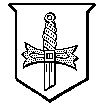
Ex. Argent, a sword proper couped, hilted or.

HONOUR POINT. That part of the shield
between the precise middle chief and
the fess point. In the annexed example
the large dot in the centre
shows the fess point; the point within
the letter D, the honour point.
See p. 6.
HORNED. This term is used to denote that the horn of a unicorn is of a different tincture from his body.
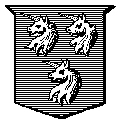
Ex. Azure, three unicorns' heads proper, erased, horned or.
HUMETTY. A term used to denote an ordinary, parts of which are couped or cut off, so that it does not touch the edges of the shield.
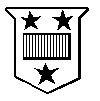
Ex. Argent, a fess humetty gules, between three mullets sable.

HURTS. Blue roundlets: the colour is expressed in the name; therefore the tincture is not otherwise named in emblazoning a coat of arms.

IMBUED. Weapons spotted with blood are said to be imbued. The example shows a spearhead imbued.
IMPALED. Two coats of arms, conjoined paleways, in one shield.
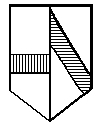
Ex. Argent, a fess gules, impaled with argent, a bend azure. See p. 38.
INCRESCENT. The new moon, with her horns turned towards the dexter side of the shield.
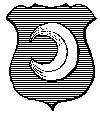
Ex. Azure, a moon increscent argent.
INDENTED. A serrated figure, much smaller than the dancette.
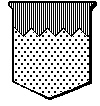
Ex. Or, a chief gules, indented.
INESCUTCHEON. The name given to small escutcheons [Page 88] forming a bearing of a coat of arms.
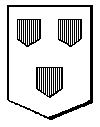
Ex. Argent, three inescutcheons gules.
INVECTED. A line formed with small semicircles, with the points turned inward. Any ordinary drawn with this line is called invected.
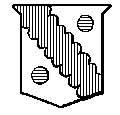
Ex. Argent, a bend gules, invected between two hurts.
ISSUANT, or ISSUING. Rays or other charges proceeding from any part of the escutcheon. See RAY.
KNIGHT. A title of honour conferred upon a subject for eminent services performed in war. In the course of time, knights that had gained riches and high titles formed societies under the control and direction of their monarchs in every part of Europe. The limits of this work will only permit us to notice the orders of knighthood introduced into England.
The KNIGHTS-BACHELORS were the earliest order of knighthood in England. The title was conferred for services in war. It was merely personal, and, like the knighthood conferred upon individuals at the present time, did not descend to their posterity.
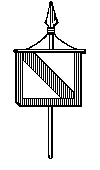
KNIGHTS-BANNERET. This ancient and honourable order has become extinct. It obtained the title of banneret from the knights having the right of [Page 89] having a square banner borne before them on the field of battle, and at jousts and tournaments. Sir W. Segar gives the following account of the creation of a knight-banneret:—"It is a military order, and can only be conferred upon persons that have performed some heroic act in the field. When this action is known to the king, or general of the army, he commands the attendance of the gallant warrior, who is led, between two knights, into the presence of the king or general with his pennon of arms in his hand, and there the heralds proclaim his merit, and declare him fit to become a knight-banneret, and thenceforth to display a banner in the field. Then the king or general causes the point of the pennon to be cut off to make it square; it is then placed at the top of his lance, and the new-made knight returns to his tent, the trumpets sounding before him." Knights-banneret were certainly created in the reign of Edward I., but how long before that time it is impossible to tell.
KNIGHTS OF THE GARTER. This is considered the most honourable order of knighthood in Europe: it was founded by Edward III. in 1349; the fraternity consists of twenty-six knights, to which are added the princes of the blood royal. The king of England is the sovereign of the order; their officers are a prelate, chancellor, registrar, and king-at-arms.
The college of the order is in Windsor Castle, with the chapel of St. George and the chapter-house. These buildings were erected by the royal founder expressly for the accommodation of the knights of [Page 90] the garter.
The garter is considered the principal ensign of this order: it is worn on the left leg below the knee; it is formed of blue velvet, edged with gold: on the velvet is embroidered the motto of the order, HONI SOIT QUI MAL Y PENSE.
The collar is of gold, weighing thirty ounces troy weight, and contains twenty-six garters enamelled proper, in each a rose gules between; the garters are connected by knots. The George is attached to this collar: it represents St. George (the patron Saint of the order) attacking the dragon; it is of gold enamelled, and may be enriched with jewels at the pleasure of the possessor.
THE KNIGHTS OF ST. PATRICK. This illustrious Irish order was founded by George III., 1783. It consists of the sovereign, a grand master, the princes of the blood royal, and thirteen knights. The lord-lieutenant for the time being is grand master. The device on the jewel of this order is argent, a cross saltier gules surmounted with a trefoil vert, charged with three imperial crowns or, the whole inclosed in a circle of gold, bearing the motto QUIS SEPARABIT. MDCCLXXXIII. An engraving of this jewel will be found on the sinister side of the title-page.
THE KNIGHTS OF THE THISTLE. The most ancient order of the Thistle was founded by James V. of Scotland, 1540, and revived by James II., king of Great Britain, 1687, incorporated by Queen Anne, whose statutes were confirmed by George I. The order consists of the sovereign and twelve brethren or knights. Their motto is the national motto, NEMO ME IMPUNE LACESSET; their badge or jewel, St. Andrew, supporting a cross, surrounded [Page 91] with rays of gold, an engraving of which will be found on the dexter side of the title-page.
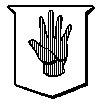
KNIGHT AND BARONET. A degree of honour next to a baron, created by King James I. to induce the English gentry to settle in the province of Ulster. The title is knight and baronet; it is hereditary: the arms are distinguished by an augmentation of a human hand gules, generally borne on an escutcheon in the centre of the shield.
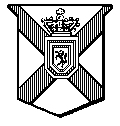
KNIGHT AND BARONET OF NOVA SCOTIA. A new creation during the reign of George I. to induce capitalists to settle in that part of North America. The title is hereditary: the arms are argent, St. Andrew's Cross gules surtout, an escutcheon or, with a lion rampant gules within a double tressure of the same, surmounted by a king's crown as a crest.
KNIGHTS OF THE BATH. An ancient and honourable military order of knighthood. The date of its origin is too remote to be traced with certainty: by some authors it is said to have been instituted in Normandy before the Conquest; it was re-established in England by Henry IV., and revived by George I. The chapel of this order is Henry VII.'s chapel in Westminster Abbey: the Dean of Westminster for the time being is always dean of the order of the Bath. The number of the knights is according to the pleasure of the sovereign. At the close of the late war the Prince Regent, afterwards George IV., remodelled this order of knighthood; [Page 92] and to enable himself to bestow marks of honour upon the naval and military officers that had distinguished themselves on the ocean and in the field, he divided the order into three classes: first, all the noblemen that were Knights of the Bath were henceforth to be called Knights Grand Crosses of the Bath, which was also the title of the commanders of fleets and armies that were rewarded by being admitted into the highest class of this noble order.
The second class are called Knights Commanders of the Bath; a great number of naval and military officers above the rank of captains in the navy and majors in the army are admitted into this class.
The third class is styled Companions of the Order of the Bath, and is open to officers of inferior rank.
The Knights Grand Crosses of the Bath attach the initials K.G.C.B. to their names and titles.
The Knights Commanders use the initials K.C.B.
The Companions are known by the initials C.B.
LABEL. The noblest of abatements serving as a difference between the eldest and the junior sons. See DIFFERENCE.
LANGUED. A term derived from the French word langue, tongue. It signifies in Heraldry that the tongue of a bird or beast is of a different tincture from the body.
LION. The strength, courage, and majestic deportment of this noble animal, has gained him the regal titles of monarch of the forest and king of beasts. Ancient heralds selected the figure of the lion as symbolic of command, strength, power, courage, and other qualities attributed to that animal. Armorists have introduced lions to denote the attributes of majesty, [Page 93] might, and clemency, subduing those that resist, and sparing those that yield to authority. The lion has been depicted in every attitude which could by any means be construed into a compliment to the person the sovereign delighted to honour, by raising him to a rank that enabled him to bear arms. Was it a warrior, who, though victorious, was still engaged in struggling with the foes of his sovereign, the lion rampant was considered a proper emblem of the hero. The warrior having overcome his enemies in the field, yet retaining his military command for the safety and honour of his country, was typified by the lion statant gardant. We might easily find examples to show the propriety of the emblem for all the positions of the lion introduced as charges in coats of arms; but the two given will be sufficient: the rest may easily be imagined by the intelligent reader. The following are the most usual positions in which the lion appears in shields of arms:—
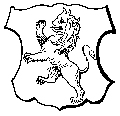
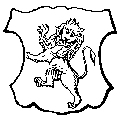
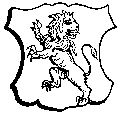
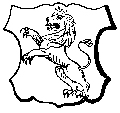
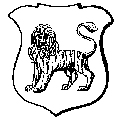
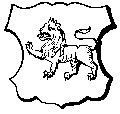
When the lions' heads are placed in the same position as in rampant gardant and regardant, they are then said to be passant gardant and regardant.
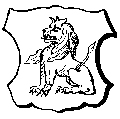
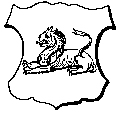
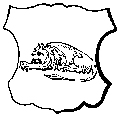
| Sejant. | Couchant. | Dormant. |
Thus far the lion is drawn in natural positions; [Page 95] these are considered the most honourable, as they have never been properly inserted in arms but for persons of high authority and pre-eminent courage and virtue. There are a great many deviations from the above, which are marks of great honour. It is considered that a lion cannot bear a rival in the field; therefore if two or more lions are introduced they are supposed to be lion's whelps, or in Heraldic terms lioncels.
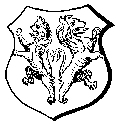
Two lioncels addorsed or back to back.
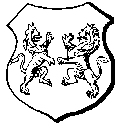
Lioncels combatant.
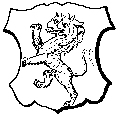
Lion rampant double-headed.
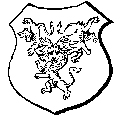
An incorporated lion gardant in the fess point.
There are a great number of ways of introducing [Page 96] this charge: many of them will be seen under the proper words that describe their condition: such as the word debruised, where the lion is confined by the fess passing over it; demi-lion or half lion; but the examples here given will be sufficient to explain their positions, active or passive. If no mention is made of the tincture it is always supposed that they are proper, that is, to be coloured like nature: they are introduced in arms of every metal and tincture known in Heraldry.
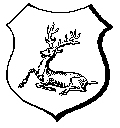
LODGED. A stag sitting on the ground with its head erect, is said to be lodged.
LOZENGE. An angular figure, known as diamond-shaped, to distinguish it from the square.
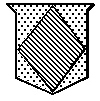
Ex. Or, a lozenge vert.
LOZENGY. Covered with lozenges.
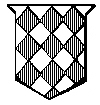
Ex. Lozengy gules and argent.
LUNA. The moon: it formerly signified argent in emblazoning the arms of sovereigns.
[Page 97]MANCHE. An ancient sleeve with long hangings to it.
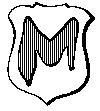
Ex. Argent, a manche, gules.
MANED. When the manes of horses, unicorns, &c. are of a different tincture from their bodies they are said to be maned.
MANTLE. A long robe or cloak of state.
MANTLING. The flowing drapery forming the scroll-work displayed on either side of the helmet from beneath the wreath, representing the ancient covering of the helmet, used to protect it from stains or rust. When the mantling incloses the escutcheon, supporters, &c., it represents the robe of honour worn by the party whose shield it envelopes. This mantle is always described as doubled, that is, lined throughout with one of the furs, as ermine, pean, vary. For examples of mantling, see the arms and crests of England, Scotland, and Ireland.
MARQUIS. The second order of nobility in England, next in rank to a duke.
MARSHAL. A title of honour. See EARL MARSHAL.
TO MARSHAL. To place persons in due order, according to their precedency, in public processions, such as coronations, proclamations of peace or war, funerals, &c.
MARSHALLING ARMS. The disposing of several coats of arms belonging to distinct families in the same escutcheon, together with their ornaments, parts, and appurtenances.
MARTLET. An imaginary bird said to be without legs; [Page 98] it is used both as a charge and a difference.
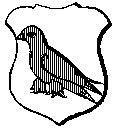
Ex. Argent, a martlet, gules.
MASCLE. An open lozenge-shaped figure, one of the subordinate ordinaries.
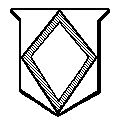
Ex. Argent, a mascle, vert.
MEMBERED. A term used to express the beak and legs of a bird when they are of a different tincture from its body.
MERCURY. The name of the planet, used by ancient heralds to describe purple in blazoning the arms of sovereigns.
METAL. The two metals used in Heraldry are gold and silver, called or and argent. It is against the rules of Heraldry to place metal upon metal, or colour upon colour, unless for special reasons. Therefore, if the field be of any colour, the bearing must be of one of the metals, and on the contrary, if the field be of one of the metals, the bearing must be of some colour.
MILLRIND. The iron placed in the centre of a grindstone to protect the hole in the centre from the action of the axis; it is a charge frequently borne on escutcheons of persons connected with agriculture.
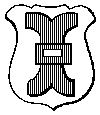
Ex. Argent, a millrind, gules.
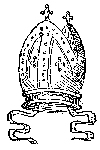
MITRE. A sacerdotal ornament for the head, worn by Roman Catholic archbishops and bishops on solemn occasions. Certain English abbots formerly wore mitres, and they are frequently found as charges in the arms of abbeys and monasteries. The annexed is a representation of the mitre of the archbishops and bishops of the church of England, borne as a mark of distinction over the arms of the see, or over their paternal achievements, when impaled with the arms of their see. The prelates of the Protestant Church of England never wear mitres.
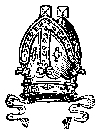
The Bishops of Durham were formerly princes of the Palatinate of Durham, and wore a ducal coronet surmounted by a mitre. They still retain the coronet and mitre as an heraldic distinction, borne over the arms of the bishopric.
MORION. A steel cap or helmet formerly worn by foot soldiers below the rank of gentlemen.
MOTTO. A word or short sentence inserted in a scroll, which is generally placed beneath the escutcheon; in some instances it is placed above the crest. The motto frequently alludes to the name of the bearer of the arms, as the motto of the Right Honourable Lord Fortescue—FORTE SCUTUM SALUS DUCUM, a strong shield is the safety of commanders. Sometimes the motto is the watchword or war-cry in the battle where the original bearer won the honours that [Page 100] are retained by his descendants. Generally the motto is founded upon the piety, loyalty, valour, fortitude, &c. of the persons to whom arms were granted.
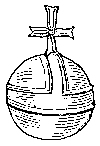
MOUND. A globe encircled with a band and surmounted with a cross; it is an ensign of royalty, signifying dominion.
MULLET. From the French word molette, the rowel of a spur: it is generally drawn with five points, as in the annexed example: when more points are used they are named.
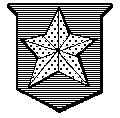
Ex. Azure, a mullet or.
MURAILE. A French term for walled.
MURREY. A word used by ancient armorists instead of sanguine.
NAIANT. A French term for swimming. This term is used in Heraldry when a fish is drawn in an horizontal position.
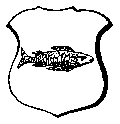
Ex. Argent, a salmon proper, naiant, its head towards the sinister side of the shield.
NAISSANT. A French word signifying coming out. It is used when a lion or any other animal appears to be rising out of the centre of an ordinary.
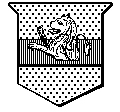
Ex. Or, from the midst of a fess, [Page 101] gules, a lion rampant naissant.
NEBULÉ, or NEBULY. A French
word, signifying cloudy, represented
by a curved line, thus—
![]()
NOBILITY. Under this denomination are comprehended—dukes, marquises, earls, viscounts, and barons only. Archbishops and bishops are included in the rank of clergy.
NOMBRIL POINT. That part of the shield below the fess point. See page 6, letter F.
NORROY. The name of one of the Kings-at-Arms.
See King-At-Arms.
NOWED. This word signifies tied or knotted, and is applied to serpents, wiverns, or any animals whose tails are twisted and enfolded like a knot.
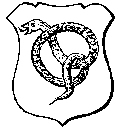
Ex. Argent, a serpent nowed proper.
OGRESSES. Black roundlets.
OR. The French word for gold. This tincture is denoted in engraving by small points.

Ex. Or, a bend gules.
ORANGES. Roundlets tinctured tenne.
ORDINARY. A term used to denote the simple forms [Page 102] which were first used as heraldic distinctions, and therefore called honourable ordinaries, as conferring more honour than later inventions. They are the chief, pale, bend, bend sinister, fess, bar, chevron, cross, and cross saltier. There are thirteen subordinate ordinaries. The form, size, and place that the honourable and subordinate ordinaries occupy in an achievement are all described in the Manual, and in this Dictionary under their different names.
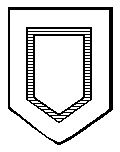
ORLE. A subordinate ordinary composed of double lines going round the shield at some distance from its edge; it is half the width of the bordure.
OVER ALL. This expression describes a figure borne over another and obscuring part of it.
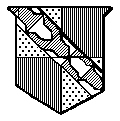
Ex. Quarterly or and gules, over all a bend vair.
PALE. One of the honourable ordinaries formed by two perpendicular lines drawn from the base to the chief. The pale occupies one third of the shield.
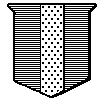
Ex. Azure, a pale or.
PALL. A scarf in the shape of the letter Y, forming part of the vesture of a Roman Catholic prelate. It is introduced as the principal bearing of the archbishops of Canterbury, Armagh, and Dublin.
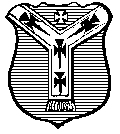
Ex. Azure, on a pall argent, four crosses [Page 103] fitchy sable, in chief a cross pattee of the second.
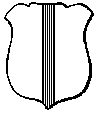
PALLET. A diminutive of the pale.
PALY. A field divided by perpendicular lines into several equal parts of metal and tincture interchangeably disposed.

Ex. Paly of four, argent and gules.
PARTY or PARTED signifies divided, and applies to the several parts of an escutcheon parted by a line, which always runs in the direction of one or more of the honourable ordinaries, as may be seen in the following examples:—

PARTED PER PALE AND PER BEND SINISTER Counterchanged, or and gules..
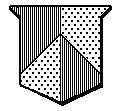
PARTED PER PALE AND PER CHEVRON [Page 104] Gules and or, counter changed.
PARTY PER FESS. A shield parted in the centre by an horizontal line through the fess point.
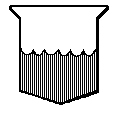
Ex. Party per fess, engrailed, argent and gules.
PARTY PER PALE. This signifies a shield parted by a perpendicular line down the centre, so that one shield may contain two coats of arms.
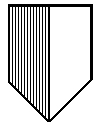
Ex. Parted per pale, gules and argent.
PASCHAL LAMB, or HOLY LAMB.
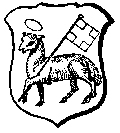
Ex. Argent, a lamb passant, carrying a banner charged with a cross.
PASSANT. Passing or walking. See LION PASSANT and PASSANT GUARDANT.
PATONCE. See CROSS.
PATTE. A cross small in the centre, wide at the ends. See CROSS.
[Page 105]PATRIARCHAL CROSS. Cross used by patriarchs in the Greek church. See CROSS.
PEARL. A precious stone, used by ancient heralds for argent in emblazoning the arms of peers.
PEAN. The name of a fur, the field sable, the tufts or.
PEER. Name given to all persons included in the rank of nobility.
PELLETS. A name given to black roundlets.
PENDANT. A shield suspended or hanging from a branch of a tree, or from a nail. Shields of arms frequently appear drawn thus in architecture, and when described are said to be pendant.
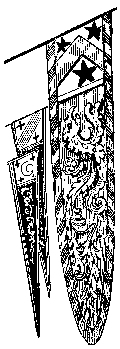
PENNONS. Small flags borne at the end of a lance of an esquire or gentleman bearing his paternal arms. The end of the pennon was cut off upon the person being created a knight banneret. See BANNERET. Penoncels or Pencils were small flags decorating the helmet or the horse armour. They are now only used at funerals. The large flag in the engraving is a pennon, the smaller, penoncels or pencils.
PHEON. A missile instrument with a barbed head, thrown from a cross bow.
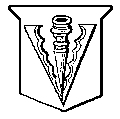
Ex. Argent, a pheon proper.
PIERCED OR PERFORATED. Cut through the centre.
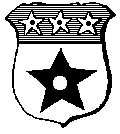
Ex. Argent, a mullet pierced, sable, on a chief azure, three mullets pierced, of the first.
PILE. An angular figure like a wedge, formed by lines running from the dexter and sinister chief to the middle base.
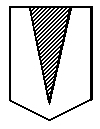
Ex. Argent, a pile, purpure.
IN PILE. Arms or other charges that are placed so as to form the shape of a pile are said to be borne in pile.
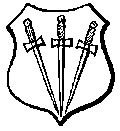
Ex. Argent, three swords in pile, their points towards the base.
PLATE. One of the six roundlets; its colour is argent, but the tincture is not mentioned, as the plate is always silver.
POMEIS. Green roundlets.
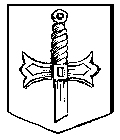
POMMELLED. The pommel of the sword is the round ball or knob at the end of the hilt of a sword.
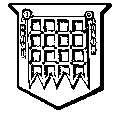
PORTCULLIS. A grating suspended by chains, used to defend the entrance to a castle.
POTENT. The ancient name of a crutch: when the field is covered with figures like small crutches it is called potent; when the heads of the crutches touch each other it is called counter potent.
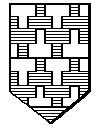
Ex. Argent and azure, potent and counter potent. Some armorists call counter potent vary cuppy.
PRINCE. The only Principality in Great Britain is that of Wales. The title of Prince of Wales is usually conferred upon the eldest son of the British monarch. All other sons, grandsons, brothers, uncles, and nephews, are called princes of the blood royal. For instance, the Duke of Cambridge, the uncle of Queen Victoria, is styled His Royal Highness Prince Adolphus Frederick Duke of Cambridge.
His son is styled Prince George of Cambridge.
PRINCESS. Daughter of a sovereign. In England the eldest daughter of the monarch is called the Princess Royal; the others by their Christian names.
PROCLAMATION. A publication by the authority of the King. Proclamations of peace or war, or other matters of importance, are usually read by one of [Page 108] the heralds. They are addressed to the whole community under their different orders or ranks, viz. Clergy, Nobility, Gentry, Burgesses, and Commons.
PROPER. This word is used to denote that animals introduced as charges in an escutcheon appear in their natural colour. Modern writers on Heraldry consider this word superfluous, as the omission of the name of any metal or tincture is quite sufficient to make any person conclude that a lion, horse, or other animal is to be represented as it appears in nature.
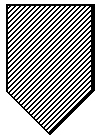
PURPURE. The colour of purple, described in engraving by lines drawn diagonally from the sinister to the dexter side of the shield.
PURSUIVANTS. Four officers of the Heralds' College, whose duty it is to attend the King-at-Arms on public occasions, and preside over certain departments of the Heralds' Office.
| They are called — | Rouge Croix, Blue Mantle, Rouge Dragon, Portcullis. |
They are entitled to rank as gentlemen, but not esquires.
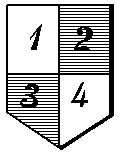
QUARTERED. A shield divided into four equal parts by a cross is said to be quartered. The quarter occupying the dexter chief is marked 1, or the first quarter; that occupying the sinister chief, 2; the dexter base, 3; the sinister base, 4; as in the annexed example.
QUARTERLY. This term is used to signify that the [Page 109] shield is quartered. In describing the royal arms of England we should say—Quarterly, first and fourth gules, three lions passant guardant, or. Second, or, a lion rampant gules, within a double tressure of the same, flory and counter flory. Third, azure, a harp or, stringed, argent.
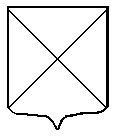
QUARTERED OR PARTED PER SALTIER. A field divided by diagonal lines crossing each other in the centre of the field.
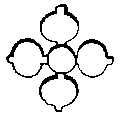
QUARTER FOIL. A four-leaved flower.
QUARTERINGS. An escutcheon divided into any number of squares is said to contain as many quarterings; they may be as numerous as the arms required. An escutcheon containing a number of quarterings is called a genealogical achievement.
QUADRATE. Square. See CROSS QUADRATE.
QUARTER PIERCED. See CROSS QUARTER PIERCED.
RADIENT. Any charge having rays or beams about it.
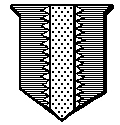
Ex. Azure, a pale, or, radient.
RAGULY. Any bearing that is ragged, like the trunk or limbs of a tree lopped of its branches, is said to be raguly. See CROSS.
[Page 110]
RAMPANT. Any beast in a fighting attitude.
See LION RAMPANT.
RAY. A stream of light proceeding from a luminous body.
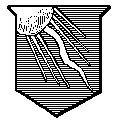
Ex. Azure, a ray of the sun issuing out of the dexter corner of the escutcheon. The lines on each side are not noticed.
REST. The figure inserted in the illustration of the word "clarion" is by some writers on Heraldry thought to represent a rest for a lance, and they give the charge that name. See CLARION.
REGARDANT. An animal looking towards the sinister side of the shield. See LION REGARDANT.
RIBAND. A diminutive of the bend.

Ex. Gules, a riband, or.
ROUNDLETS. Small round figures, all named from different metals and tinctures. See p. 8.
RUBY. A precious stone, formerly used instead of gules.
SABLE. The term used in Heraldry for black.
SALIENT. An animal springing forward. See LION SALIENT.
SALTIER. One of the honourable ordinaries, by Scottish heralds called St. Andrew's Cross.
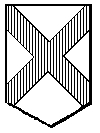
Ex. Argent, a saltier, gules.
SANGUINE. One of the heraldic tinctures. It is a dark red or blood colour. By some armorists it is called murrey. The latter word is considered obsolete.
SAPPHIRE. The name of a precious stone, formerly used to express azure.
SARDONYX. A precious stone, formerly used to denote sanguine in emblazoning the arms of the English nobility.
SATURN. The name of a planet, used to denote sable in emblazoning the royal arms by ancient armorists.
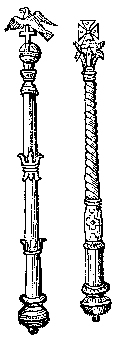
SCEPTRE. A royal staff; an ensign of sovereignty borne in the hand. It was originally a javelin without a head. Sceptres of the present time are splendidly decorated with jewellery. The annexed engraving represents two sceptres of the kings of England: the sceptre with the dove is of gold, three feet seven inches long; the circumference of the handle is three inches, and two inches and a quarter at the end of the staff; the pomel is decorated with a fillet of table diamonds and other precious stones; the mound at the top is enriched with a band of rose diamonds; upon the mound is a small cross of Calvary, over which is a dove with its wings expanded, as the emblem of mercy.
The royal Sceptre with the Cross is of gold; the [Page 112] handle is plain, and the upper part wreathed; it is in length two feet nine inches, the fleur-de-lis of six leaves; the mound, and the cross above it, are richly embellished with amethysts and diamonds.
SCARPE. A diminutive of the bend sinister.

Ex. Argent, a scarpe, gules.
SCROLL. The riband below the escutcheon, on which the motto is inscribed.
SEEDED. When the seed of a rose or any other flower is of a different tint from the petal, it is called seeded. The heraldic colour of the seed in the centre of a flower is or, but, as in other proper names, the colour of the seed is not mentioned unless it is of a different tincture.

SET FOIL OR SIX FOIL. Six leaves conjoined in the centre.
SEGREANT. This term is used to describe a griffin displaying its wings as if about to fly.
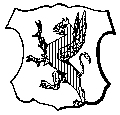
Ex. A griffin rampant, segreant, gules.
SEJANT. French word for sitting. See LION SEJANT.
SEMÉ. A French word for strewed. A field powdered [Page 113] or strewed with any object is said to be semé: thus a shield may be semé of fleur-de-lis, semé of hearts, &c.
SINISTER. A term used in Heraldry to signify the left side of any object. Thus a bend proceeding from the top of the left side of the shield is called a bend sinister.
SLIPPED. Torn from the stock or branch.
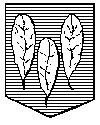
Ex. Azure, three laurel leaves slipped, argent.
SOL. A planet, formerly used to denote or, in emblazoning royal arms. It is the Latin name for the sun.
SOL, or THE SUN IN ITS SPLENDOUR. The sun is said to be in its splendour when it is figured (that is, delineated with a human face) and surrounded with rays. Sometimes this figure is called a sun in its glory.
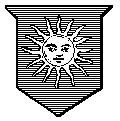
Ex. Azure, a sun in its splendour.
STANDARD. A large square flag bearing the whole of the achievements of the monarch or nobleman, as seen in the royal standard of England. The royal standard, when placed before the pavilion of the monarch either at a tournay or in an encampment, was eleven yards long and three yards broad.
The length of the standard when borne in the [Page 114] field denoted the rank of the leader: that of a duke was seven yards long; a peer of lower degree raised a standard five yards in length; that of a knight banneret was only four. In modern times standards of peers or knights banneret are seldom displayed but in funeral processions. The standard is then long and narrow, and pointed at the end; that of a duke is about fifteen feet in length, peers of lower degree about twelve.
The flag borne as the ensign of a regiment of cavalry is called a standard. The flags of foot soldiers are called colours.
STAR. This celestial figure is always represented as argent, and is supposed to have six rays or points; if they have more points the number must be named. See ETOILE.
STATANT. An animal standing still with all its legs on the ground. See LION STATANT.
SUPPORTERS are figures standing on the scroll, placed on each side of the shield as if to support it. Supporters in English Heraldry are granted only to persons included in the rank of nobility or to knights banneret by favour of the sovereign.
The origin of this addition to the external ornaments of the escutcheon may be traced to the practice which originally prevailed in the regulation of tournaments. Some days prior to the tournament taking place, each knight desirous of entering the lists was required to hang up his shield, upon which his arms were emblazoned, at the place appointed by the prince or nobleman that proclaimed the tournament, that they might be examined by the heralds, to prevent unqualified persons entering the lists. Each shield thus exhibited was guarded or supported by the servants of the knight to whom it belonged, [Page 115] and to disguise their livery these guardians of the shield assumed the appearance of savages, Moors, lions, griffins, and various other animals.
In after times, on the creation of a peer, the Heralds selected the supporters they deemed most appropriate, having some allusion either to the deeds, name, title, arms, or motto of the newly-created peer.
SURMOUNTED. A figure or bearing having another over it.
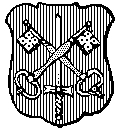
Ex. Gules, a sword erect in pale, argent, surmounted by two keys, saltier, or.
SURTOUT. The French word for "over all." See ESCUTCHEON OF PRETENCE and OVER ALL.
TALBOT. A dog formerly used for hunting. It is formed something between a hound and a beagle, with a large snout, and long, round, thick ears.
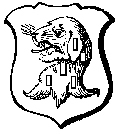
Ex. Argent, a talbot's head erased, semé of billets.
TENNE, or TAWNEY. One of the tinctures used in emblazoning arms. It signifies orange colour, and is represented in engraving by lines drawn diagonally from the sinister to the dexter side of the shield, traversed by perpendicular lines from the base to the chief.
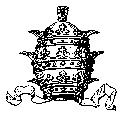
TIARA. The Pope's mitre, with its triple crowns.
TINCTURE. A term used in Heraldry to express colour.
TOPAZ. The name of a precious stone, formerly used instead of or, in emblazoning the arms of the English nobility.
TORTEAUX. Red roundlets.
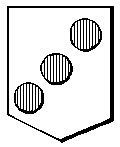
Ex. Argent, three torteaux in bend, sinister.
TOURNAMENTS were combats of honour, in which persons of noble birth entered the lists to gain reputation in feats of arms. The name is derived from tourner, to turn, from the horsemen turning frequently as they rode round the enclosure, and during the course of the engagement. The design of tournaments was to train the nobility to the use of arms; none, therefore, were admitted to these sports but persons of noble birth, who could prove their descent, at least, by three generations. They were also required to be men of unspotted honour and integrity.
It was customary for princes, on some public festivity or rejoicing, to appoint a day for these entertainments, and give public notice to the knights in their own territories, as well as in the neighbouring states.
The knights generally made their appearance four days before the combat. They endeavoured to excel [Page 117] each other in the splendour of their equipage and dress, and in the excellence and beauty of their horses, which were adorned with the most costly caparisons. Their armorial ensigns were displayed with great pomp during three days, that all who viewed them might judge if they were worthy of entering the lists. The field where the tournament was to be held was railed in with pales. This place was called the lists. A king was appointed to preside over the sports, as were also judges to examine the knights' armour and arms, and to see that no unfair advantage was taken. A number of other officers were appointed, which our space will not allow us to mention.
A short distance from the lists were the galleries and pavilions for the spectators; the most splendid was that fitted up for the lady who presided as queen of the tournament and her attendants, all splendidly attired. The most noble and most beautiful ladies of the court crowded to these martial entertainments to inspire the combatants with ardour, by giving them some token or favour, such as a scarf, veil, or bracelet, with which the knight adorned his helmet or spear.
Their arms were lances of light wood, without iron at the top; swords without edge or point; in some instances wooden swords were used. The knights were formed into two parties, and entered the lists by different barriers, riding round the lists several times to pay their respects to their sovereign and the ladies. At length the heralds sounded to arms; the quadrils, or troop, took their stations; when the charge was sounded, the knights rushed against each other with the utmost impetuosity. The clashing of swords, the sounding shields, the war-cry of the knights, who shouted the name of their ladye-love in the midst of the mimic strife, greatly excited the spectators, who, [Page 118] in return, cheered and encouraged the combatants. When the knights were brave and determined, the contest lasted some hours; the vanquished, that is, those who were thrown from their horses, withdrew from the lists as quietly as possible, leaving the field to their successful opponents. The victory was decided by the number of knights unhorsed. The prizes to the victors were adjudged and delivered by the queen and the ladies. This authority of the fair sex contributed greatly to polish the manners of the nobility and gentry of the middle ages, who were anxious to court the favour of those who were the distributors of public honours.
Sometimes this entertainment was followed by jousts. Two cavaliers, out of gallantry, would break a lance in honour of the ladies. These were followed by others until the lists were again cleared for the tournament. The difference between tournaments and jousts was, that the former were in the nature of battles, the latter of duels.
When the sports were over, the heralds and pursuivants declared the names and titles of the knights, and proclaimed the heraldic ornaments which the emperor, king, or prince that presided at the tournament granted to those whom he pleased to reward or favour.
Notwithstanding all the precautions to prevent the mischief that might happen at these martial exercises few were exhibited in which a great number were not wounded, some killed in the melée, others crushed by the falling of the scaffolds, or trod to death by the horses. Kings, princes, and gallant knights from every part of Europe have perished at different times while attending or taking part in those mimic battles. Successive popes thundered [Page 119] out their anathemas against all that encouraged this warlike and dangerous amusement. Those who perished in these sanguinary entertainments were denied the honour of Christian burial; and yet, so strong was the passion of the nobility of Europe for these martial sports, from a desire to display their grandeur, courage, and address before the ladies and the assembled multitude, that no bulls, decretals, or anathemas of the church were able to restrain them. The use of gunpowder, and the consequent inutility of armour to defend the person in battle, gradually put an end to these animating shows. The tragical death of Henry II. of France, in 1559, who was accidentally killed in a tournament, caused laws to be passed prohibiting their being held in that kingdom. They were continued in England till the beginning of the seventeenth century.
An attempt was made to revive these martial exhibitions in Scotland, a few years ago, by Lord Eglintoun, the acknowledged leader in all manly sports, elegant athletic exercises, and baronial liberality. This noble peer proclaimed a tournament to be held at Eglintoun Castle on the 28th and 29th of August, 1839. The lists were duly prepared, a covered pavilion was erected for the accommodation of the ladies, which would contain 3000 persons. In front of this pavilion was the throne of the Queen of Beauty and her attendants. Around the lists, at convenient distances, were arranged the tents or pavilions of the knights, over which floated the gonfalon, or great banner, emblazoned with the arms and motto of the knight to whom the tent was appropriated, penons and penoncils fluttered at each angle of the pavilion, and the shield was placed over the entrance. The knights vied with each other in the decoration [Page 120] of their pavilions; all was in accordance with ancient customs: and if the shade of Froissart had witnessed the scene, it could not have complained of modern innovation or misplaced ornament. The procession of the King of the tournament, the Queen of Beauty, with the judges, heralds, pursuivants, halberdiers, musicians, men-at-arms, as also the splendid retinues of the noble challenger and the gallant knights, presented a scene unparalleled for magnificence and heraldic emblazonment since the days of Edward IV. Every form was observed in this modern tournament; and a more interesting scene for the historian, the antiquary, and armorist, could not be exhibited. Unfortunately, the continued rain cast a gloom over this animated spectacle, which nevertheless excited the highest admiration of all who beheld it: a spectator of the scene could well imagine the enthusiasm similar ones would create in the minds of the gay and brave of former times. It is deemed necessary to briefly notice the last tournament held in Britain; as any one that requires full information on every part of heraldic ornament, processional arrangement, and technical definition, may find positive examples in the details of this gorgeous exhibition.
TRANSPOSED. Charges or bearings placed contrary to their usual situation.
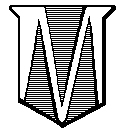
Ex. Argent, a pile, azure, issuing from the chief between two others, transposed.
TREFOIL. Three-leaved grass: the shamrock of Ireland. [Page 121] When a flower or leaf is introduced as a charge in a shield of arms, if it is of its natural colour, or, in heraldic language, proper, the tincture is not named, but if of any other colour it must be described.
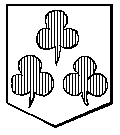
Ex. Argent, three trefoils, gules, one over two.
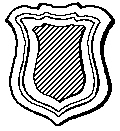
TRESSURE. An ordinary not so broad as an orle. It generally forms a border to the inescutcheon. Tressures are frequently borne double, and sometimes treble. They are generally ornamented flory and counter-flory. The example contains only a single tressure. The arms of Scotland exhibit an example of a double tressure flory and counter-flory, as exhibited in the shield on the title-page of this Manual. See DOUBLE TRESSURE.
TRICORPORATED. Three lions rampant, conjoined, under one head, guardant, in the fess points. See LIONS.
TRIPPING. The motion of deer, between running and walking.
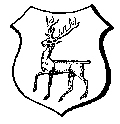
Ex. Argent, a stag proper, tripping.
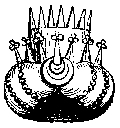
TURBAND. In coats of arms, where the knight was a Crusader, this figure often appears. It was the form of the sultan's turban at that period.
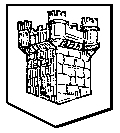
TURRETED. A wall or castle having small turrets. In the annexed example the square tower has circular turrets at the angles, and is therefore said to be turreted.
TUSKED. Any animal having tusks of a different tincture from its body is said to he tusked.
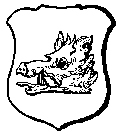
Ex. Argent, a boar's head, erased proper, tusked gules.
UNDY. A term used to express the word wavy by Gwillim and other ancient armorists.
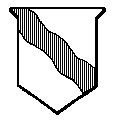
Ex. Argent, a bend undy, gules.
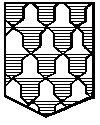
VAIR. A kind of fur formerly used for the lining the garments of knights. It is represented in engraving by the figures of small bells ranged in lines, as in the annexed example. Unless the colour of the fur is named, vair is always argent and azure. The bend, the cross and saltier, are sometimes formed of this fur.
VAMBRACED. Armour for the arms.
[Page 123]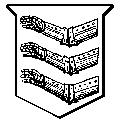
Ex. Argent, three dexter arms, vambraced, couped.
VAMPLATE. A word used by ancient heralds for armour for the hand, instead of gauntlet.
VENUS. The name of the planet, used for the colour vert by ancient heralds, who emblazoned the arms of sovereigns by planets instead of metals and colours.
VERDOY. A bordure charged with eight leaves.
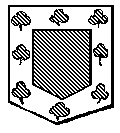
Ex. Vert, a bordure argent, verdoy, of trefoils.
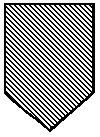
VERT. Green. It is represented in engraving by diagonal lines drawn from the dexter to the sinister side of the shield.
VISCOUNT. A title of honour, a degree below an earl.
VOIDED. A term applied when any part of an ordinary is left open to the field.
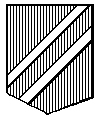
Ex. Gules, a bend sinister, voided, argent.
VOIDER. A subordinate ordinary.
[Page 124]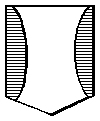
Ex. Azure, a voider, argent.

VOLANT. The French word for flying. It is used in Heraldry to express the same action.
VORANT. Swallowing or devouring: any animal, in a charge, devouring another creature.
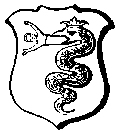
Ex. Argent, a serpent crowned, or, vorant an infant.
VULNED. A word that signifies wounded, used in emblazonry to denote an animal wounded by another creature.
VULNING. Any creature in the act of wounding itself.
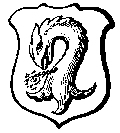
Ex. Argent, a pelican's head, erased, vulning.
WALLED. A term sometimes used in Heraldry. When an ordinary is edged or guarded by an embattled wall.
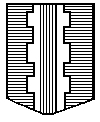
Ex. Azure, on a pale, walled on each [Page 125] side with three battlements argent, an endorse gules.
WAVY. Curved lines, undulating like the waves of the sea.
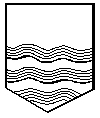
Ex. Argent, the lower half of the shield three bars wavy, azure.
WHITE. This word is only used to describe a plain fur. It is represented as argent.
WINGED. When the wings of a bird, or those of chimerical figures which are drawn with wings, are of a different tincture to their bodies, they are said to be winged. Thus, in the arms of the state of Venice there is a lion sejant guardant, winged or.

WINGS ERECT. Wings are called erect when their long feathers point upwards.

WINGS INVERTED. When the feathers point downwards.
WIVERN. A chimerical animal, the upper part resembling a dragon.
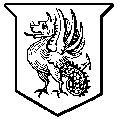
Ex. Argent, a wivern, wings raised.

WREATH. A chaplet of two different-coloured silks wound round each other, and placed on the top of the helmet for the crest to rest upon. In Heraldry it is usually drawn straight, as in the lower example.
In the preface to this Manual, we stated that Heraldry might be considered as the symbolic history of the nobility of Britain, from the Conquest to the reign of Elizabeth. It would require a volume of far greater pretensions than this to enter fully upon the heraldic history of the peerage; but the assertion may be borne out by merely glancing at the supporters of the shields containing the arms of the British monarchs during that period.
Supporters were not introduced in English heraldry previous to the reign of Richard II. The shield of this luxurious monarch is supported on each side by an angel habited, and beneath the shield by a white hart couchant, gorged and chained or, beneath a tree. The shield of Henry IV., the founder of the Lancastrian dynasty, was supported on the dexter side by a swan, on the sinister side by an antelope, both gorged and lined or. The shield of the gallant Henry V. was supported on the dexter side by a lion rampant guardant, crowned or; on the sinister side by an antelope, gorged and chained. Henry VI. had two antelopes as supporters to his achievement. The shield of the gallant Yorkist Edward IV. is supported on the dexter side by a lion rampant argent, the tail passed between his legs, and turned over his back; on the sinister by a white [Page 128] hart, and in some instances by a bull. The supporters of the shield of Richard III. were two boars rampant argent, tusked and bristled or. Henry VII., as a descendant of the Welch prince Cadwallader, assumed the red dragon as the supporter of the dexter side of his shield; the sinister was supported by a greyhound argent, collared gules. The shield of Henry VIII. was supported on the dexter side by a lion guardant, crowned or; on the sinister by a dragon gules. Edward VI. had the same supporters. Mary on her marriage with Philip of Spain, empaled the arms of Spain and England as baron and femme; the dexter side of the shield was supported by the imperial eagle, the sinister by a lion rampant, crowned or. Queen Elizabeth rescued England from this degradation; the crowned lion rampant of England resumed his place as the supporter of the dexter side of the shield, and the red dragon on the sinister. On the union of England with Scotland, the supporters of the royal arms were, on the dexter side a lion guardant, crowned or, on the sinister maned and unguled or, white unicorn, gorged and chained of the same. The supporters of the royal arms have continued the same to the present time; and, as an emblem of union and strength, long may they continue.
The reader may easily read the vicissitudes and changes of dynasty in the great change of these emblems of support and dignity during the period of time that elapsed from the reign of Richard II. to James I.; and even the brief notice here given would enable the reader to determine the date of any building if the royal arms and supporters were placed within it.
Heraldry had taken too firm a hold of the minds of the higher classes of society to escape the notice of the architects who were engaged by the sovereigns of England [Page 129] and by the wealthy barons, to erect those splendid ecclesiastical edifices that still exist as the architectural gems of Britain. Westminster Abbey teems with heraldic ornament, not only in the gorgeous chapel of Henry VII., but in those parts of the structure erected at a much earlier period. During the time when those styles of Gothic architecture prevailed that are now called the decorated and the perpendicular, the roof, the columns, the stained glass windows, the seats, altar, tombs, and even the flooring, were filled with emblazonment. A branch of art which our forefathers found so useful as an ornament to architecture cannot be beneath the notice of those who are desirous of treading in their footsteps.
Nor was heraldic ornament confined to architecture. It formed the grand embellishment of the interior of the palaces and baronial castles,
"The gorgeous halls which were on every side,
With rich array and costly arras dight."
The canopies of state, the furniture and plate, were all emblazoned with the arms of the royal and noble owners. And even at the present day, heraldry is far more effective for interior decoration than the unmeaning Italian scroll-work that is substituted for it. Some idea of the value of both may be formed by glancing at the interior decoration of the new Royal Exchange; and it is to be regretted that the shields containing the arms of the different countries should not have occupied the walls, as an indication of the spot where the natives of those countries might be found; and that the compartments of the ceiling, if such ornament should be found in a building of this kind at all, should not be filled with the Italian floral scroll decoration.
In a preceding chapter of this Manual, the reader has [Page 130] been informed that the arms of a knight were emblazoned on the surcoat or outer garment that was worn over his armour, which was the origin of the term Coat of Arms. Heraldic emblazonment was plentifully strewed over the mantles of the nobility when they assembled on state solemnities. Nor was this ornament confined to the garments of males. Ladies delighted to appear in the cognizances of their lords, or in their own paternal bearings. Armourists that have amused themselves by treating on the curious and obsolete terms of heraldry, have supposed that the flanch and flasque represent that part of female attire which covered the body from the lower part of the neck to the waist, and that this part of the ladies' dress contained the heraldic bearing. Our contracted space will not allow our indulging in fanciful research, nor would it benefit our readers if we did so. Suffice it that we have ample proof that heraldry formed the decoration of female attire.
Numerous instances may be found, either in stained glass, monumental brasses, or illuminated genealogies, of female figures bearing heraldic devices on their apparel. A married lady or widow had her paternal arms emblazoned upon the fore part of her vest, which by ancient writers is called the kirtle, and the arms of the husband on the mantle, being the outer and the most costly garment, and therefore deemed the most honourable. This is called bearing arms kirtle and mantle.
Our frontispiece contains two figures kneeling, taken from Dallaway's Heraldry. They are to be found in an illuminated pedigree of the Weston family. The male figure is that of Sir John de Weston, of Weston-Lizars, in Staffordshire, and Isabel his wife, whose paternal name was Bromley. In three quarterfoils [Page 131] beneath the figures are shields: the first contains the arms of Weston, sable, an eagle displayed or, with a lable argent, fretty gules; the centre shield is argent, fretty gules; that under the lady is her paternal arms, quarterly per fess dancette, or and gules. The figure of the knight is represented in chain armour, over which is a surcoat, on which his arms are emblazoned. The vest or kirtle of the lady is formed entirely of the colours of her arms disposed quarterly, and parted horizontally, or fessways, by the line dancette. As both the knight and his lady appear together, each bears their own arms; but if either had been drawn separately, the arms of both would have appeared on one person; if on the male, they would have been empaled baron and femme upon the surcoat; if on the female, they would have appeared on kirtle and mantle. This lady is drawn with a kirtle only.
In some of the later monumental brasses, the arms on female figures are arranged differently; the arms of the baron appearing on the outside of the mantle, hanging over the dexter shoulder, the paternal arms of the femme on the lining of the mantle turned outwards on the sinister side of the figure.
The reader will find, by referring to the word TOURNAMENT in the Dictionary, that Heraldry formed the great embellishment of that animated and costly amusement: and that the attainment of heraldic honours was the only means of gaining permission to join in it, and by this means only was a passport obtained to high society. These honours, which cost some trouble in gaining, could be lost by misconduct. Arms were forfeited for uncourteous demeanour, disregard of authority, falsehood, oppression, and ungentlemanly conduct; and there can be little doubt but, in a semi-barbarous age, when prowess in the field of battle was [Page 132] considered the highest acomplishment, that the dread of a blot on the escutcheon, or a reversal of the shield of arms, restrained many a proud baron in his tyrannical proceedings to those beneath him, and tended to keep down the insolence of the upstart favourites of royalty. Heraldry tended to soften and polish the manners, and, by the introduction of the manufacture of silken housings tapestry, and carpeting, to increase the comforts and pleasures of society, and compelled those who were anxious to exhibit the insignia of gentility, to seek distinction by other means than rapine and violence.
The term Canting Heraldry frequently occurs in ancient and modern authors. It is a term of contempt and derision, applied to symbolic bearings that are assumed without the authority of the Heralds' College. In many cases they allude to the name or occupation of the bearer: the motto is probably a pun upon the figures contained in the shield, or some technical expression used by the parties in their agricultural or commercial pursuits.
No person, when heraldry was in its greatest repute, dared assume any cognizance or bearing without permission of the Earl Marshal or the Kings-at-Arms. Any individuals, who presumed, by assumption, to offend the laws of the court of honour, were liable to heavy fines and personal duresse, which in many instances have been rigidly enforced.
THE END.
This day, price 7s. cloth gilt,
OR, EXPLANATIONS OF DIFFICULT DOCTRINES AND MISINTERPRETED TEXTS.
By the Rev. JOHN CUMMING, D.D., F.R.S.E
This day, price 7s. 6d., post 8vo., cloth,
AN OLD, OLD STORY.
By the Author of "Mary Powell"
New and Cheaper Edition.
Price 6s., in antique.
With numerous Woodcuts. Price 2s. 6d., in cloth.
DEBORAH'S DIARY. With Illustrations. Cheap edition, price 2s.
HOUSEHOLD OF SIR THOMAS MORE. Price 2s. 6d.
THE COLLOQUIES OF EDWARD OSBORNE. Price 2s. 6d.
THE OLD CHELSEA BUN HOUSE. Uniform.
In post 8vo., price 12s.,
A History of the Early Inhabitants of Britain, down to the Conversion of the Anglo-Saxons to Christianity. Illustrated by the Ancient Remains brought to light by recent research. By THOMAS WRIGHT, Esq. M.A., F.S.A. With numerous Engravings. New edition, enlarged.
All in super-royal 8vo., price 10s. 6d. each, cloth gilt; or 21s. each in morocco.
Illustrated by Twenty-four Engravings on Steel, Two Maps, and many superior Woodcuts.
"We have at length, in this attractive
volume, the desideratum of a complete
picturesque guide to the topography of
Jerusalem."
—Patriot.
"The volume is well got up in point of
embellishments, and contains much valuable matter, with illustrations beautifully
executed."
—Ch. of England Mag.
"Our impression is, that Jerusalem was
never before so successfully delineated."
—Evangelical Magazine.
IN SYRIA, GREECE, AND ITALY.
A Succession of Visits to the Scenes of New Testament Narrative. With Twenty-three Steel Engravings, and several Woodcuts.
"This is one of the happiest of the many
happy Christmas ventures that the publishers
have put forth. It is got up in
excellent taste, and written in a pleasing
and attractive style."
—Church and State
Gazette.
"If beauty of design and execution, combined with
elegance of narrative and
trustworthy description, can be any recommendation
to a book, it is sufficient to
say that this excellent volume possesses
every one of these features, and establishes
its own character without the need of any
further praise."
—Bell's Messenger.
OR, THE FOUNDERS OF NEW ENGLAND IN THE REIGN OF JAMES THE FIRST.
With Twenty-eight Illustrations on Steel, and numerous Woodcuts.
"This is a good thing well done; a book
that ought to be a household treasure in
the family of the more than fifty millions
of Englishmen and Americans, who are, if
right-minded men, most deeply interested
in the history it details. The story of the
plantation of British America is, with the
sole exception of the Sacred Records, the
most important narrative in the annals of
the world. No discovery of new lands like
that of Columbus—no discovery in science,
or in arts, approaches it in the magnitude
of its glorious results."
—Standard.
"We can commend Mr. Bartlett's book
as handsomely issued, carefully got together,
and full of interesting reading.
The illustrations are sufficiently varied—alternating
between the Fens of Lincolnshire,
the flats of Holland, and the scenery
of Plymouth Sound."
—Athenæum.
Illustrated with Twenty-three Engravings on Steel, and several Woodcuts.
"As a work of reference it is of the
highest utility; as an ornamental book it
is unsurpassed; and as a guide to the
traveller it has no equal in the English
language."
—Observer.
"This is a very handsome and pleasing
pictorial hand-book of the beauties of
Sicily. The illustrations do honour alike
to the artist, engraver, and publishers—and
the style is, generally speaking, graphic
and faithful ... with an interest
beyond its pictorial claims."
—Athenæum.
ON THE TRACK OF THE ISRAELITES;
OR, A JOURNEY FROM CAIRO BY WADY FEIRAN TO MOUNT SINAI AND PETRA.
Illustrated with Twenty-seven Engravings on Steel, a Map, and numerous Woodcuts.
"Mr. Bartlett has made a book, pleasant
in letter-press, as well as attractive in its
illustrations—delicately finished line engravings
of subjects particularly well
chosen."
—Athenæum.
"A very handsome volume, copiously
and cleverly illustrated in the vignette
style; an elegant table-book, or most
acceptable present."
—Atlas.
"Entertainingly written, and crowded
with steel engravings of a superior character,
which combine to make it a very
handsome volume."
—Critic.
OR, GLIMPSES OF THE LAND OF EGYPT.
Illustrated by Thirty-five Steel Engravings, Maps, and numerous Woodcuts.
"There is an actuality about the descriptions,
and a beauty about the illustrations,
that render this glimpse of Egypt
peculiarly charming. The sketches and
descriptive maps render the views witnessed
in the 'Nile Boat' beautiful
realities."
—The Sun.
Illustrated by Twenty-eight Steel Plates and Maps, and Twenty-three Woodcuts.
"The reader will find abundance of interesting
and amusing information in the
volume. As a work of art, it possesses
very considerable merit."
—Chambers's
Journal.
"An individual of able research and
active observation conveys to us his impressions
in language terse, concise, and
never tedious; we listen with pleasure to
his tale. Well executed pictorial illustrations
considerably enhance the merits
of this pleasing work."
—Tait's Magazine.
With Twenty-two Steel Engravings and Woodcuts.
"A beautiful monument for a lover of
Art."
—Athenæum.
"An interesting book to look through,
and a useful book to read,"
—Leader.
"Mr. Bartlett was a remarkably clever
and faithful sketcher, and had an unusual
power of expressing space and size in the
limits of a small vignette."
—Guardian.
This day, price 7s. 6d., post 8vo., cloth,
By the Author of "Mary Powell."
"Close the curtains, draw the sofa by
the fire, fit the ottoman to your feet, and
adjust the light. If the reader be thus
prepared he is ready to commence reading
'The Day of Small Things.' What is
this neat and unpretending volume by the
authoress of 'Mary Powell?' It is a string
of pearls. Yes. Yet the simile will not
be perfect unless the thread on which they
are strung be golden. Then we will accept
the resemblance.... The authoress of
'Mary Powell,' and, we add, 'The Day of
Small Things,' feels her own power, and
knows how deeply trifles, when judiciously
introduced, will tell.... It is a cornucopia
filled with rich moral fruits of every
kind; and, though small are the hints
thrown out here and there, or the advice
casually given, still in the aggregate their
voice becomes powerful, and we find that
we have been reading a powerful lesson
while we were scanning the jottings of a
diary.... The work is worthy of its
author, and will be a general favourite."
—Atlas.
New and Cheaper Edition, post 8vo., price 7s. 6d., cloth gilt,
"A tale as touching and alluring as it
is simple—a tale sure to interest, whether
by its sweet scenes of pathos, its continuous
interest, its exquisite traits of
nature, or its unaffected, unobtrusive tone
of true piety."
—Literary Gazette.
"In every thing that the author of 'Mary
Powell' writes, there is a pleasant vein of
quiet, refined cheerfulness, which, like the
tone of a sweet voice, makes one listen
with pleasure."
—Athenæum.
Second Edition, price 7s. 6d., post 8vo., cloth, with Frontispiece,
A Tale of Auvergne.
"It is written in a clear, pointed style,
embellished with original fancies, and
eloquent with an earnest meaning. The
various scenes and characters are obviously
studies from life—the life of restlessness,
of fear, of devotion, among the
friends of martyrs, described by the
chroniclers of that epoch, stained with
the blood of fanatical wars and persecutions.
Colette, as delicately and distinctly
limned in the successive chapters, might
have formed a figure in the fifteenth-century
group, drawn by a home-inspired
artist. Then, the struggle round the walls
of Le Puy is a picture of olden warfare, of
arquebus and halberd battles, of priestly
soldiers, sworn to shed no blood, but
casuistically, with a ponderous club, immortalizing
the miserable routiers. Again,
the crétin is a portrait painfully accurate.
Indeed, the entire story is vivified by its
evident reality."
—Athenæum.
Third Edition, price 7s. 6d., post 8vo., cloth, with Coloured Frontispiece by WARREN,
"On the basis of the true history of
Palissy, the writer has formed the present
work; has given a very spirited sketch of
his labours; has exhibited the extravagances,
amounting to crime, of a man of
genius driving on in pursuit of his darling
object; and has depicted, as the title promises,
with a good deal of power, the
plagues of a wife who has such a husband."
—Christian Observer.
In post 8vo., price 7s. 6d. cloth gilt,
TWILIGHT IN AN UNINHABITED HOUSE.
OF A FINE OLD ENGLISH MERCHANT.
FATHER AND SON.
A GENTLEMAN OF THE OLD SCHOOL.
A GHOST STORY.
CHARLES LAMB.
SIR FRANCIS BARING.
ON LEAVING AN OLD FAMILY HOUSE.
LONE HEATHS AND HIGHWAYMEN.
ON THE SACRED AFFECTIONS.
A SCRAP OF AUTOBIOGRAPHY.
THE EMPEROR ALEXANDER.
THE EVELYNS OF WOTTON.
FABIAN'S DILEMMA.
CLAREMONT AND THE PRINCESS CHARLOTTE.
THE FATHER OF A FAMILY.
In post 8vo., price 7s. 6d., cloth gilt, with Frontispiece,
A Tale of the Tyrol.
"A highly interesting volume, in which
the noble stand made by an army of peasants
for independence is told with great
power and pathos."
—Morning Herald.
"Sweet 'Mary Powell' exchanges her
lute for a cymbal, clanging with her white
fingers upon the sounding brass. The
subject is well chosen, and the theme
inspiriting. 'Hofer' is the hero of her
lute."
—Art-Journal.
New Edition, price 7s. 6d., cloth gilt, with Coloured Frontispiece after WARREN,
"The hero of the narrative is, in plain
English, a Bible hawker among Roman
Catholics chiefly; and his difficulties, ill-treatment,
conversations, and beneficial
influence, form the staple of the book—
his character is well drawn."
—English
Churchman.
"The volume is one of no ordinary
merit; for it throws intense interest around
common occurrences and common characters,
and presents not only a vivid series
of pictures, but a well-sustained tale."
—Church and State Gazette.
Post 8vo., cloth, price 7s. 6d., with Frontispiece,
"It may be said of all her works, that
of their kind they are very good; and
this cannot fail to give pleasure to every
reader capable of appreciating literary
merit, and it will commend itself for
family reading, on account of the genial
tone of the morality which runs throughout."
—Atlas.
Third Edition, post 8vo., price 7s. 6d., antique,
Afterwards MISTRESS MILTON.
"This is a charming little book; and
whether we regard its subject, cleverness,
or delicacy of sentiment and expression,
—to say nothing of its type and orthography,
—it is likely to be a most acceptable
present to young or old, be their
peculiar taste for religion, morals, poetry,
history, or romance."
—Christian Observer.
Price 2s. 6d. boards; 3s. 6d. cloth,
OR, SCENES FROM THE LIFE OF A PRIVATE PUPIL.
"There is no reason to complain of
any want of vivacity in this story. The
author has made himself well qualified
for the task, and excites mirth by the
recital of some curious adventures. If any
of our readers wish to read a very entertaining
and laughter-provoking story,
we cannot do better than suggest a perusal
of 'Frank Fairlegh.'"
—Somerset Gazette.
Price 3s. boards; 4s. cloth,
OR, THE RAILROAD OF LIFE.
"The task of the reviewer becomes a
pleasant one when such works as the one
before us is forced upon his perusal. We
must once more commend the taste and
talent of the author of 'Lewis Arundel.'"
—Weekly Times.
"Sparkling like a firefly, 'Frank Fairlegh'
bustles through the scenes of his
story, if not the most profound, certainly
one of the gayest and prettiest writers of
the day."
—Bath Journal.
Price 1s. 6d. boards; 2s. 6d. cloth,
OR, A CLOUD AND ITS SILVER LINING.
This day, in fcap., price 2s. boards; 2s. 6d, cloth,
Edited by F.E. SMEDLEY, Esq., Author of "Frank Fairlegh," &c.
Cheap Edition, 2s. boards; fine paper, 4s, cloth gilt,
By WILLIAM HOWITT. With Designs by HARVEY.
"All the boys in England, whether
'old boys' or young ones, will rejoice in
this fascinating book, full of anecdote and
wild adventure."
—Athenæum.
"A capital book, full of humour, adventure,
excitement, and those incidents of
peril and pleasure which seem indigenous
to Australia."
—Church and State Gazette.
"In vivid portraiture of things as they
are, it far excels every publication that
has yet reached us from Australia."
—British Banner.
Fcap. 8vo., 7s. 6d., cloth lettered,
By Mrs. J.B. WEBB. New Edition, with Designs by GILBERT, and View and Plan of Jerusalem.
"It is in truth an admirable little
volume, and well worthy of a yet more
extensive patronage than it has already
received."
—Maidstone Journal.
"One of the most interesting works we
have read for some time. We are not surprised
at the popularity it has attained
—it deserves it; and we cordially wish it
further success."
—Metropolitan.
"The plot is easy, natural, and well sustained.
The narrative gracefully written....
Seldom have we read a tale better
adapted for its purpose."
—Monthly Review.
Tenth Edition, corrected and enlarged, 18mo., 2s. 6d. cloth; or 3s. scarlet, gilt edges,
With brief Explanatory Notes, arranged for the use of Schools and Families. By JOSEPH PAYNE.
"A very nice little volume, containing
a charming collection of poetry."
—Spectator.
"It is really a treat to see anything so
simply good as the little volume before us."
—Metropolitan Magazine.
"Pieces that are at once sprightly and
instructive, pathetic and devout."
—Congregational
Magazine.
"A very pleasing and suitable collection."
—Westminster Review.
New and Cheaper Edition, with Illustrations by GILBERT, fcap., 3s. 6d. cloth
OR, TALES OF TRAVELLERS. By MARIA HACK.
Fcap., 3s. 6d. cloth, or 5s. gilt edges,
A Tale of the Rice Lake Plains. By Mrs. TRAILL. New and Cheaper Edition, edited by AGNES STRICKLAND. Illustrated by HARVEY.
"A very delightful book for young
readers. The interest is deep and well
sustained. Mr. Harvey has contributed
some excellent woodcuts, and the book is
altogether a pretty and interesting one."
—Guardian.
"The book is exceedingly well calculated
for children, to whom its interesting
contents, its handsome appearance, and
beautiful illustrations, will render it an
acceptable present."
—Tait's Magazine.
New and Improved Edition, with Frontispiece, 18mo., 1s. 6d. cloth gilt,
An ILLUSTRATED EDITION, in large type, with 16 Cuts by GILBERT, 16mo., 2s. 6d. cloth, gilt edges.
"These verses for children have never
been surpassed for the happy union of fancy
and precept, the simplicity and intelligibility
of the ideas and words, and the
fluency and conciseness of the rhymes."
—Spectator.
By the same Authors,
New and Improved Edition, with Frontispiece, Two Vols., 18mo., 1s. 6d. each, cloth gilt.
32mo. cloth, gilt edges, 1s.,
OR, PIETY AND TRUTH TRIUMPHANT.
A Tale for the Young.
16mo. gilt edges, 2s. 6d.,
By EMILY TAYLOR. With Sixteen fine Woodcuts, from LANDSEER'S Designs.
"A delightful book for children. The
birds tell of their habits to a little inquiring
boy, who goes peeping into their
nests and watching their doings, and a
very pleasant way they have of talking,
sure to engage the young reader's attention.
The designs are pretty, and nicely
cut on wood."
—Spectator.
In foolscap 8vo. cloth, 2s. 6d.,
OR, THE STORY OF A GENIUS.
A Tale for Boys. By the Author of "John Halifax Gentleman," &c. With Four Illustrations by FRANKLIN.
"No one possessing common sensibility
can read this book without a thoughtful
brow and a glistening eye."
—Chambers's
Edinburgh Journal.
"An exceedingly well-told tale, which
will interest boys of all ages.... As a
holiday companion, few books would be
more popular."
—English Churchman.
"A lively narrative of school-boy adventures."
"A very charming and admirably-written volume.... It is adapted to make boys better."
"A simple and pleasing story of school-boy
life."
—John Bull.
In fcap. 8vo., 7s. 6d., elegantly bound and gilt,
THE STORY OF A CHILD'S LIFE AMIDST THE WOODS AND HILLS.
By ELIZA METEYARD. With numerous Illustrations by HARVEY.
"This is a very delightful book, especially
calculated for the amusement and
instruction of our young friends; and is
evidently the production of a right-thinking
and accomplished mind."
—Church of
England Review.
"An elegant, interesting, and unobjectionable
present for young ladies. The
moral of the book turns on benevolence."
—Christian Times.
"This Story of a Child's Life is so full
of beauty and meekness, that we can
hardly express our sense of its worth in
the words of common praise."
—Nonconformist.
"This will be a choice present for the
young."
—British Quarterly Review.
"The whole story is told with a most
touching grace, and a golden glow of
poetry pervades it. The fine designs of
Harvey, which illustrate the book, add
greatly to its attractiveness, and we cannot
entertain a doubt of its becoming one
of the most popular volumes in the 'Children's
Library.'"
—Eliza Cook's Journal.
Second Edition, in square 16mo., handsomely bound in cloth, price 2s. 6d. with gilt edges,
OR, RHODA'S LESSON.
A Story Book for the Young. By the Author of "Life for a Life," &c. With Illustrations on Steel.
"A very captivating story."
—Morning
Post.
"Just what a story for children ought
to be."
—Douglas Jerrold's Newspaper.
"Truthfulness, descriptive talent, and
pure morality in every line."
—Literary
Gazette.
16mo. cloth, price 2s.,
OR, FIRST READING LESSONS.
By the Author of "Aids to Development," &c. &c. With Twenty-four Engravings on Wood.
Fcap. 8vo., price 3s. 6d. cloth gilt,
A Book for Girls. By JANE WINNARD HOOPER. Illustrated by FRANKLIN.
"A pretty unpretentious volume, neatly
embellished, and gay in its livery of green
and gold. Outside and in 'tis precisely
the beau ideal of a present or a prize-book
for a young lady. More fresh and more
delightful reading than this book it has
rarely been our fortune to meet."
—Morning
Advertiser.
"An amusing series of descriptions
likely to interest the young folks for
whom they are intended."
—Express.
18mo. cloth, price 2s.,
With Illustrations.
A New and Revised Edition, with Eighty-eight cuts, 18mo. cloth lettered, price 2s.,
OR, A PEEP INTO THE COUNTRY.
In 18mo. cloth, price 2s.,
With Cuts.
New Edition, cloth, 1s.; gilt edges, 1s. 6d.,
With Anecdotes and Reflections, by the Rev. INGRAM COBBIN, M.A. With Frontispiece and Fifty-seven Woodcuts.
In small 4to., price 21s., cloth and gold,
THE WYE, AND THE COAST.
By Mr. and Mrs. S.C. HALL. With Drawings on Wood by J.D. Harding, F.W. Hulme, W.S. Coleman, D.H. M'Ewen, Birket Foster, and other artists.
Cheaper Edition, in One Volume, price 12s. bound in cloth; in morocco, 21s.,
By Mrs. S.C. HALL.
With Notes and Illustrations by F.W. FAIRHOLT, F.S.A.
|
Birth-place of John Bunyan. Burial-place of John Hampden. Residence of Hannah More. Tomb of Sir Thomas Gresham. Tomb of Thomas Gray. Birth-place of Chatterton. Birth-place of Richard Wilson. House of Andrew Marvel. Tomb of John Stow. Heart of Sir Nicholas Crispe. Printing Office of Caxton. Shaftesbury House. Dwelling of James Barry. Residence of Dr. Isaac Watts. Prison of Lady Mary Grey. Studio of Thomas Gainsborough. Tomb of John Kyrle. |
Tomb of William Hogarth. Grave of Izaak Walton. Grave of William Penn. Monument of Wren. Grave of Lady Rachel Russel. Edgeworthstown. Garden of Sir Thomas More. Esher—Residence of Jane Porter. Grave of Sir Richard Lovelace. Grave of Grace Aguilar. Dwelling of Edmund Burke. Remains of Clarendon House. Flaxman's Monument. Village of Eyam. Monument of Edward Bird, R.A. Grave of Mrs. Hofland. Chertsey and its Neighbourhood. |
"Descriptions of such Shrines come
home with deep interest to all hearts—all
English hearts—particularly when they
are done with the earnestness which distinguishes
Mrs. Hall's writings. That
lady's earnestness and enthusiasm are of
the right sort—felt for freedom of thought
and action, for taste, and for genius winging
its flight in a noble direction. They
are displayed, oftentimes most naturally,
throughout the attractive pages of this
volume."
—Observer.
"Mrs. Hall's talents are too well known
to require our commendations of her 'Pilgrimages,'
which are every way worthy
of the beautiful woodcuts that illustrate
almost every page: and this is very high
praise indeed."
—Standard.
"The illustrations are very effective;
and the whole work, externally and internally,
is worthy of the patronage of
all who love to be instructed as well as
amused."
—Church and State Gazette.
"The book is a pleasant one; a collection
of a great deal of curious information
about a number of curious places and
persons, cleverly and readily put together,
and combined into an elegant volume."
—Guardian.
Author of "Proverbial Philosophy."
In a handsome volume, cloth, gilt edges, price 7s. 6d.,
"There is an elaborate sumptuousness
about it that is quite imposing."
—Saturday
Review.
"These Sonnets will increase his reputation,
for they are decidedly the best
things we ever saw of his."
—Globe.
"A work which, for its moral purpose
and its handsome form, is well calculated
to grace any library in the kingdom."
—Observer.
"There is a great deal in the present
volume which will appeal to English feelings."
—Illustrated News of the World.
Cheap Edition, in One Vol., price 2s. 6d. boards; 3s. 6d. cloth,
AND OTHER TALES.
With Illustrations by JOHN LEECH.
"We have rarely had occasion to speak
more highly of any work than of this.
The purpose of the writer is admirable,
the manner of his working out the story
is natural and truthful, and the sentiments
conveyed are all that can be desired."
—Bell's Weekly Messenger.
"This charming tale has won its way to
the well-merited distinction of a 'Popular
Edition,' embellished with a characteristic
frontispiece from the telling pencil of John
Leech. We can read it again and again
with fresh pleasure."
—Literary Gazette.
Third Edition, with Vignette, fcap., cloth, 7s. 6d.,
AND OTHER POEMS.
Second Edition, fcap., cloth, 3s. 6d.,
Fcap., cloth, 2s. 6d., with Portrait,
Translated into French.
Price 3s., cloth,
In Three Vols., price 18s., cloth,
OR, LECTURES ON THE BOOK OF REVELATION.
New Edition, thoroughly revised, corrected, and arranged.
| I. | THINGS THAT WERE. |
| II. | THINGS THAT ARE. |
| III. | THINGS THAT WILL BE. |
This Work has undergone a most elaborate revision and correction by the Author. New matter of great value has been introduced, allusions to circumstances now obsolete have been expunged, and fresh and interesting evidence of the fulfilment of the prophecies of the book have been added. These volumes form a LIBRARY EDITION of a work of unprecedented popularity, replete with interest, and strikingly illustrative of a much neglected portion of the Word of God.
In fcap., price 3s. 6d., cloth,
A CHAPTER IN PROVIDENCE
"The genius of the preacher has fallen
on a theme peculiarly agreeable, abounding
in nature, truth, simplicity, and pathos.
We predict for the publication a very
extensive and enduring popularity."
—British Standard.
"If the story loses somewhat of its
simplicity under the glowing pen of the
eloquent doctor, it gains, on the other
hand, by the pure evangelical tone which
runs like a golden thread through all the
history."
—Atlas.
"Indeed, the book is a woman's book,
and we shall be much mistaken if it do
not prove more attractive—as it will be
certainly more useful—to sensible women
than half the sentimental trash which they
are insulted by having offered to them."
—Freeman.
Second and Cheaper Edition, in fcap., price 5s., cloth,
OR, LEAVES FROM THE TREE OF LIFE.
"There are few of the varieties of human
trouble, or the forms and appliances of
Christian solace, that are not described by
the author."
—Literary Gazette.
"The present volume is worthy to take
rank with the best and most successful of
the Rev. Author's previous works. Its
consolations are leaves gathered from the
tree of life, fresh in their lovely verdure,
impregnated with the sweet odours of the
Gospel. The author's contributions to
religious literature are marked not less
by their eminently evangelical and practical
characters, their purity and loftiness
of thought, than by their beautiful simplicity
of language and style."
—Morning
Herald.
"This volume is eminently practical,
and is marked by all the author's characteristic
excellences. We have not read a
book from Dr. Cumming for a long time
which we can more conscientiously commend."
—Weekly Christian News.
Cheap Edition, Tenth Thousand, in One Volume, containing 688 pages, price 6s., cloth lettered,
Between the Rev. JOHN CUMMING, D.D., and DANIEL FRENCH, Esq., Barrister-at-Law, held at Hammersmith, in 1839.
"No clergyman's library can be complete
without it."
—Bell's Messenger.
"A compendium of argument."
—Gentleman's
Magazine.
"The subject (pro and con) is all but
exhausted."
—Church and State Gazette.
"This cheap reprint of a masterly discussion
contains the most comprehensive
view of all points at issue between Protestants
and Romanists with which we are
acquainted."
—Biblical Review.
|
Price 1s. 6d. each. THE FINGER OF GOD.CHRIST OUR PASSOVER. THE COMFORTER. Or 2s. 6d. in cloth gilt. |
Price 1s. each. INFANT SALVATION.MESSAGE FROM GOD. BAPTISMAL FONT. Or 2s. with gilt edges. |
In 4to., cloth, gilt edges, 21s.,
OR, GUIDE TO FAMILY WORSHIP.
With Twenty-four Engravings.
The Services are meant to embody the wants, and praises, and intercessions of Christians of every section of the Church of Christ. Any family of any branch of the Protestant Church may use them. They are meant for man in the world, and designed to render family worship full, without tediousness. They are suited, the writer trusts, by the generality and commonness of the prayers, for every class and type in this busy world. With earnest hearts to feel and use them, and the teaching of God's Holy Spirit, these forms may become instinct with life, and unload many a full soul that cannot strike out words for itself. The Annotations are necessarily few.
This work is designed to introduce or facilitate the practice of Family Worship.
By constructing the daily prayer on the passage of Scripture selected for reading,
greater variety, interest, and practical use are associated with the exercise. What
God declares is thus solemnly accepted in prayer; what He promises is embraced by
adoring hope; and for special blessings disclosed or promised in his holy word,
thanksgiving and praise are ascribed to Him from whom cometh down every good and
perfect gift, to whom belong the glory and the honour.
Shortly.
OR, POPULAR AND PRACTICAL EXPOSITIONS OF THE NEW TESTAMENT.
Vol. XII.—THE EPISTLES OF ST. JAMES, &c., price 6s. in cloth.
Into the Comments and Expositions will be introduced illustrative extracts from a variety of valuable sources, giving clear illustrations of disputed passages; so that when the series on the New Testament is finished, every family may find in the library a storehouse of useful, interesting, Protestant, and evangelical instruction.
Vols. I. to IV.—THE FOUR GOSPELS, price 20s.
Vol. V.—THE ACTS OF THE APOSTLES, price 7s.
Vol. VI.—EPISTLE TO THE ROMANS, price 4s. 6d.
Vol. VII.—THE CORINTHIANS, price 5s.
Vol. VIII.—GALATIANS, EPHESIANS, AND PHILIPPIANS,
price 6s.
Vol. IX.—COLOSSIANS AND THESSALONIANS, price 4s. 6d.
Vol. X.—TIMOTHY, &c., price 4s.
Vol. XI.—THE HEBREWS, price 5s.
THE REVELATIONS, price 7s. 6d.
"One of the most valuable of Dr. Cumming's
numerous publications, and likely
to become the most popular, and the most
lasting in its popularity, for it has enduring
qualities which belong to all ages
and generations. The text is simply and
clearly opened—critical explanations are
given only when they are required—so as
not to encumber, but to elucidate; and
the practical applications are such as to
suit all classes of persons."
—Church of
England Quarterly Review.
"The comments are made with great
lucidity. The result is the throwing of
an additional flood of light on the already
dazzling truths of Holy Writ. The uses
of such a work are self-obvious; and
when we add that the plan is carried out
with all the lucidity, faithfulness, piety,
honest reasoning, and felicity of thought
and expression which mark its predecessors,
we have only said enough to mark
our sense of its value."
—Church and State
Gazette.
"For the purpose for which 'the Readings'
are intended, they are in every
sense admirably adapted. They combine
simplicity with faithfulness, and critical
interpretation with most attractive explanation;
so that a child may understand
them."
—Bell's Messenger.
In monthly numbers, price 4d.,
By the Rev. JOHN CUMMING, D.D., F.R.S.E.
"The Author has not published any exposition of the last prophecy of Daniel, but having studied and lectured on it in the light of existing complications and events, he is satisfied that it will prove interesting and instructive."
Price 3s. complete, in cloth.
| THE BOOKS OF SAMUEL,
price 5s. |
THE BOOKS OF KINGS,
price 4s. 6d. |
Fourth and Cheaper Edition, revised, fcap. 8vo. cloth, price 3s. 6d.,
OR, PRECEPTS AND PRESCRIPTIONS FOR CHRISTIAN LIVING.
"Popular, clear, captivating, and animated."
—British Banner.
"Dr. Cumming is famous for the number
and variety of his illustrations, chiefly
drawn from natural and familiar objects.
The volume before us strikes us as being
remarkably felicitous."
—Clerical Journal.
"It is written in the same terse and
vigorous style and earnestness of tone as
those of its predecessors, and the strong
common sense with which its teaching is
enforced, will attract while it improves
the student."
—Church and State Gazette.
Sixth Edition, in fcap. 8vo., price 3s. cloth, gilt edges,
Manual of Family Prayers for General and Special Occasions, with Short Prayers for Spare Minutes, and Passages for Reflection.
Fcap. 8vo., price 3s. 6d.
Or, Lectures on the Book of Daniel. Fcap., price 3s. 6d.
Fcap., price 3s. 6d.
Original Edition, with Index, &c. Three Vols., price 3s. 6d. each.
Or, Lectures on our Lord's Miracles and Parables, Two Vols., price 3s. 6d. each.
A Series of Scripture Studies, forming a History of the great events and characters in Scripture. By GEORGE GILFILLAN, author of "The Bards of the Bible," &c. In two vols., price 10s. 6d. cloth.
"We know no reading more fascinating
than that which Mr. Gilfillan has
provided in these volumes."
—Leader.
"A lasting monument alike of Mr.
Gilfillan's genius as a writer, and accomplishments
as a divine."
—Scottish Review.
"We cheerfully acknowledge the religious
correctness which pervades these
discourses, and admit that the style,
especially in the descriptive passages, not
unfrequently attains to real eloquence."
—Baptist Magazine.
"He has extraordinary power of word-painting,
and passages from these sermons
might be quoted, as some of the
brightest specimens of English composition."
—John Bull.
"Much that is thoughtful and true is
expressed in pleasing form, and we do not
doubt that the work will be popular."
—Clerical Journal.
Nineteenth Edition, 800 pp., 8vo. cl., strongly bound, 21s.; or in calf, 26s.,
FOR EVERY DAY IN THE YEAR,
At 5, 4-1/2, 4, 3-1/2, 3, and 2-1/2 per cent. per annum, from £1 to £100, &c. By JAMES LAURIE.
"In the great requisites of simplicity of
arrangement and comprehensiveness, we
have none better adapted for general use."
—McCulloch's Commercial Dictionary.
"Mr. Laurie was well known as one of
the most correct and industrious authorities
on commercial calculations, and the
practical value of his various tables have
long been recognised."
—Times.
Third Edition, 8vo. cloth, 7s.,
At 5, 6, 7, 8, 9, and 9-1/2 per cent, per annum, from 1 day to 100 days. By JAMES LAURIE.
New Edition, fcap. cloth, 3s.; gilt edges, 3s. 6d.,
Being a concise Description of the several Terms used, and containing a Dictionary of every Designation in the Science. Illustrated by 400 Engravings on Wood.
Price 4s. post 8vo. cloth, gilt edges,
FROM ACTUAL SURVEY, IN EGYPT, ARABIA, AND PALESTINE.
Illustrated by Seventeen Steel Engravings, Three Maps, and Thirty-Seven Woodcuts. By W.H. BARTLETT.
New Editions.
FROM THE BEST AUTHORS,
Including a great number of Originals, intended as an Appendix to Dr. Watts's Psalms and Hymns.
|
Nonpareil 32mo. Roan ——, gilt edges Morocco |
s. d. 1 6 2 0 5 0 |
|
Long Primer 24mo. Roan ——, gilt edges Morocco |
s. d. 2 6 3 0 6 0 |
|
Large Type. Sheep Roan, gilt edges Morocco |
s. d. 5 0 6 0 9 0 |
BOUND WITH WATTS'S HYMNS,
1 vol. 32mo., roan, 3s.; gilt edges, 3s. 6d.; morocco, 6s. 6d.
New Edition, fcap. 8vo. cloth gilt, 1s.,
A SELECTION OF THE PSALMS AND OTHER PORTIONS OF HOLY SCRIPTURE, ARRANGED AND MARKED FOR CHANTING.
By WILLIAM SHELMERDINE, Conductor of the Sacred Harmonic Society, and Organist of the Mechanics' Hall, &c., &c., Nottingham.
With a Preface by the Rev. J.A. BAYNES.
In crown 8vo., price 2s. 6d.,
ANCIENT AND MODERN.
Arranged for four Voices, with an Accompaniment for the Organ or Pianoforte.
To accompany the above.
In fcap. 8vo., price 5s., cloth gilt,
OR, THREE YEARS IN THE HOLY CITY.
Edited by the Rev. Professor J.H. INGRAHAM, Rector of St. John's Church, Mobile. Illustrated with Engravings.
"Our perusal of it has been only to impress
us with the ability of the author in
the use of the materials, and in the structure
of a pleasing and most affecting tale."
—Clerical
Journal.
"This is the best production of its class
that has come to our hands for a long
time, and it is but candid and just to say
that it adds very much to the stores of
knowledge already existing about the
East."
—British Standard.
"We hardly know what to say about
this book; it is written in beautiful style,
and it conveys much valuable information
as to the customs and manners of the
inhabitants of the Holy Land."
—Wesleyan
Times.
"The whole is written in a semi-poetical
style, which will prove attractive to
religious readers."
—Leader.
"The volume contains much information
as to Jewish manners and customs."
—Baptist
Magazine.
"Professor Ingraham has worked out
his plan with diligence and reverence."
—Literary
Gazette.
In post 8vo., price 7s. 6d., cloth gilt,
A Portraiture from the Life. By FREDRIKA BREMER.
"Another of those beautiful stories of
home-life in Sweden for which Miss
Bremer is so justly famed."
—Patriot.
"A work by Miss Bremer can never fail
to delight a great number of readers. It
is like a walk through the fields on a
frosty day—so free and buoyant is the
air—so fresh and sparkling the aspect of
nature and human nature in these northern
regions."
—John Bull.
"'Father and Daughter' might have
made a name for a less distinguished
writer... Of course the book will be
read by everybody. Many will applaud."
—Leader.
"The book introduces us to people and
things which are new to the novel-reading
public, and which possess in themselves
no ordinary degree of interest."
—Atlas.
In fcap., with Frontispiece, price 5s., cloth,
A Tale of German Rural Life. By the Author of "An English Girl's Account of a Moravian Settlement in the Black Forest."
"A pretty tale, from the pen of a young
but ready writer... A religious story—simple,
sketchy, and quietly romantic."
—Athenæum.
"This pretty volume is grave, thoughtful,
and frequently pathetic;—a poem in
prose, abounding in striking incident,
rapid transitions, and pleasing surprise.
It is likely to be admired by young persons,
and extensively read."
—Christian
Witness.
Improved Edition, 18mo., cloth lettered, price 1s. 6d.,
Or, ENGLISH SPELLING-BOOK; with the meaning attached to each Word. Compiled for the use of Ackworth School.
New Edition, 18mo., cloth lettered, price 2s.,
Depuis l'âge de Deux Ans jusqu'à Cinq. Avec une Interprétation Anglaise.
18mo., sewed, price 1s.,
Traduits de l'Anglais. Par M. CLEMENCE.
12mo. cloth, price 2s.,
Imitated from LA FONTAINE. Intended for Persons about to learn the French language. With a DICTIONARY. New Edition, revised and corrected by C.J. DELILLE, Professor at Christ's Hospital.
Crown 8vo., cloth, price 4s.,
By the Rev. J. CARLILE, D.D. New Edition, enlarged.
Seventh Edition, 12mo. cloth, price 1s. 6d.,
Exhibiting the Etymology and Meanings of 8,000 Words, with Lessons on Etymology, and Notes.
Crown 8vo, cloth, with Frontispiece, price 5s.,
By MARGARET E. DARTON.
"This is a valuable volume, containing
a very clear, correct account of the leading
facts connected with the surface of
the earth, and its inhabitants....
As far as it goes, it is comprehensive,
well written, and interesting, worthy
of the daughter of Maria Hack, whose
books will always be dear to the young
and the old."
—Gentleman's Magazine.
"We have rarely met with a volume
containing so much valuable information
for educational purposes as is brought
together in this volume. It is prepared,
too, in a manner which will immediately
attract the interest of the young, in whose
minds it will indelibly fix the numerous
facts, with which every page abounds."
—Bell's
Messenger.
Improved Edition, 12mo. cloth, price 2s.,
Comprising the Rules of Syntax, exemplified by appropriate Lessons under each Rule.
New Edition, 18mo., cloth, price 1s. 6d.,
On an Improved Plan.
New Edition, price 1s. 6d., in cloth,
Or, Lessons on Facts and Objects, With 130 Graphic Illustrations.
16mo. cloth, price 2s. 6d.,
By ANN RODWELL. With many Cuts. New Edition, revised by JULIA CORNER.
New Edition, 12mo. cloth, price 1s. 6d.,
In which the origin of each word is given from the Greek, Latin, Saxon, German, Teutonic, Dutch, French, Spanish, and other Languages, with the Parts of Speech, and the Pronunciation accented. By J. ROWBOTHAM, F.R.S.A.
New and Enlarged Edition, fcap. 8vo., price 5s. cloth, red edges,
With short Biographical Sketches, and Notes Explanatory and Critical, intended as a Text-book for the higher Classes in Schools, and as an Introduction to the Study of English Literature. By JOSEPH PAYNE.
"The plan and the execution are equally
good; altogether it is an excellent reading
book of poetry."
—Watchman.
"The work is deserving of commendation, as comprehending much that is excellent—the very flowers and gems of English poetry—and nothing exceptionable."
New and Improved Edition, 12mo. cloth, price 2s. 6d.,
Their History, and the Events which led to their discovery: with a short Explanation of some of the principal Natural Phenomena. For the use of Schools and Families. By E.A. WILLEMENT.
New Edition, revised, 12mo. bound, price 6s.,
Designed for every Class of Learners, and especially for Self-instruction. Containing the Elements of the SPANISH Language, and the Rules of Etymology and Syntax Exemplified; with NOTES and APPENDIX, consisting of Dialogues, Select Poetry, Commercial Correspondence, &c.
Fifth Edition, price 3s., bound,
Price 4s., bound,
Price 5s. 6d. in 12mo. and 8vo.,
In Two Volumes, 18mo. cloth, price 2s. each,
For Schools, Families, and General Reading. Explained by Historical and Geographical Illustrations, and numerous Map Diagrams.
"Every effort has been made to meet
the wants of the general reader, and we
find that he has fully succeeded in rendering
his little labours universally acceptable."
—Britannia.
"Two admirable and unexceptionable
little volumes: they display both learning
and research, and the explanations introduced
where required are singularly lucid."
—New
Quarterly Review.
"We can strongly recommend them, in
the belief that they are admirable for condensation,
clearness, and judicious selection."
—London
Quarterly Review.
OF
OLD AND NEW TESTAMENT HISTORY AND GEOGRAPHY.
Sixth edition, revised and improved, post 8vo., cloth, red edges, price 5s. 6d.,
With a Connexion between the Old and New Testaments; an Introductory Outline of the Geography, Political History, &c. By J.T. WHEELER, F.R.G.S., &c.
Fourth Edition, revised, post 8vo., cloth, red edges, price 5s. 6d.,
Including,
1. The Four Gospels harmonised into one continuous Narrative.
2. The Acts of the Apostles, and continuous History of St. Paul.
3. An Analysis of the Epistles and Book of Revelation.
4. An Introductory
Outline of the Geography, Critical History, Authenticity,
Credibility, and Inspiration of the New Testament. The whole illustrated
by copious Historical, Geographical, and Antiquarian Notes,
Chronological Tables, &c.
Small folio, illustrated by large coloured Maps, and a View and Plan of Jerusalem, extra cloth, price 7s. 6d.,
OF
THE OLD AND NEW TESTAMENTS;
Comprising a Geographical Account of every Nation mentioned in the Old and New Testaments, illustrated and explained by brief Reviews of the Political History, digested into continuous narratives.
The above Work is intended more especially to accompany the Analyses and Summaries of Old and New Testament History, but such additions have been introduced as will, it is hoped, render it of service to Biblical Students generally.
BY
MR. AND MRS. S.C. HALL
WITH NUMEROUS ILLUSTRATIONS,
We have the honour to submit to the public a "Book of the Thames, from its Rise to its Fall," hopeful that our readers may share with us the enjoyment we have so long and so often derived from the "King of Island Rivers."
We have traced the bountiful river from the bubbling well out of which it issues, in the meadow by Trewsbury Mead—its lonely birthplace—through its whole course, gathering tributaries, and passing with them through tranquil villages, populous towns, and crowded cities; ever fertilizing, ever beautifying, ever enriching, until it reaches the most populous city of the modern or the ancient world, forming thence the great highway by which a hundred nations traverse the globe. Aided by several accomplished artists, we have largely illustrated this volume, not only by engravings of its picturesque scenery, but by introducing the various objects of interest that are found upon its banks.
"It is a book to endear to us our native
England, and, produced with all the elegance
of the printer's and the binder's art,
will richly adorn the drawing-room table."
—Daily
News.
"It is by far the pleasantest book, certainly
the most complete in design and
execution, that has been published about
the Thames for many years, and we can
easily understand that in writing it the
authors performed 'a labour of love.'"
—Morning
Post.
"This is one of the best in appearance
of the ornamental works of the season ...
the binding and the typography are
excellent, and the style lively, superficial,
and showy."
—John Bull.
"A faithful as well as an agreeable
guide to whatever of interest occurs along
the entire course of the river. In short,
it is a pleasant, well-written, and very
handsome book on the pleasantest river an
author could have to write about."
—Literary
Gazette.
|
Cloth Superbly gilt Morocco |
18s. 21s. 26s. |
M'GLASHAN, DUBLIN. MENZIES, EDINBURGH.
***END OF THE PROJECT GUTENBERG EBOOK THE MANUAL OF HERALDRY; FIFTH EDITION***
******* This file should be named 16273-h.txt or 16273-h.zip *******
This and all associated files of various formats will be found in:
https://www.gutenberg.org/1/6/2/7/16273
Updated editions will replace the previous one--the old editions will be renamed.
Creating the works from public domain print editions means that no one owns a United States copyright in these works, so the Foundation (and you!) can copy and distribute it in the United States without permission and without paying copyright royalties. Special rules, set forth in the General Terms of Use part of this license, apply to copying and distributing Project Gutenberg-tm electronic works to protect the PROJECT GUTENBERG-tm concept and trademark. Project Gutenberg is a registered trademark, and may not be used if you charge for the eBooks, unless you receive specific permission. If you do not charge anything for copies of this eBook, complying with the rules is very easy. You may use this eBook for nearly any purpose such as creation of derivative works, reports, performances and research. They may be modified and printed and given away--you may do practically ANYTHING with public domain eBooks. Redistribution is subject to the trademark license, especially commercial redistribution.
*** START: FULL LICENSE ***
THE FULL PROJECT GUTENBERG LICENSE
PLEASE READ THIS BEFORE YOU DISTRIBUTE OR USE THIS WORK
To protect the Project Gutenberg-tm mission of promoting the free
distribution of electronic works, by using or distributing this work
(or any other work associated in any way with the phrase "Project
Gutenberg"), you agree to comply with all the terms of the Full Project
Gutenberg-tm License (available with this file or online at
https://gutenberg.org/license).
Section 1. General Terms of Use and Redistributing Project Gutenberg-tm
electronic works
1.A. By reading or using any part of this Project Gutenberg-tm
electronic work, you indicate that you have read, understand, agree to
and accept all the terms of this license and intellectual property
(trademark/copyright) agreement. If you do not agree to abide by all
the terms of this agreement, you must cease using and return or destroy
all copies of Project Gutenberg-tm electronic works in your possession.
If you paid a fee for obtaining a copy of or access to a Project
Gutenberg-tm electronic work and you do not agree to be bound by the
terms of this agreement, you may obtain a refund from the person or
entity to whom you paid the fee as set forth in paragraph 1.E.8.
1.B. "Project Gutenberg" is a registered trademark. It may only be
used on or associated in any way with an electronic work by people who
agree to be bound by the terms of this agreement. There are a few
things that you can do with most Project Gutenberg-tm electronic works
even without complying with the full terms of this agreement. See
paragraph 1.C below. There are a lot of things you can do with Project
Gutenberg-tm electronic works if you follow the terms of this agreement
and help preserve free future access to Project Gutenberg-tm electronic
works. See paragraph 1.E below.
1.C. The Project Gutenberg Literary Archive Foundation ("the Foundation"
or PGLAF), owns a compilation copyright in the collection of Project
Gutenberg-tm electronic works. Nearly all the individual works in the
collection are in the public domain in the United States. If an
individual work is in the public domain in the United States and you are
located in the United States, we do not claim a right to prevent you from
copying, distributing, performing, displaying or creating derivative
works based on the work as long as all references to Project Gutenberg
are removed. Of course, we hope that you will support the Project
Gutenberg-tm mission of promoting free access to electronic works by
freely sharing Project Gutenberg-tm works in compliance with the terms of
this agreement for keeping the Project Gutenberg-tm name associated with
the work. You can easily comply with the terms of this agreement by
keeping this work in the same format with its attached full Project
Gutenberg-tm License when you share it without charge with others.
1.D. The copyright laws of the place where you are located also govern
what you can do with this work. Copyright laws in most countries are in
a constant state of change. If you are outside the United States, check
the laws of your country in addition to the terms of this agreement
before downloading, copying, displaying, performing, distributing or
creating derivative works based on this work or any other Project
Gutenberg-tm work. The Foundation makes no representations concerning
the copyright status of any work in any country outside the United
States.
1.E. Unless you have removed all references to Project Gutenberg:
1.E.1. The following sentence, with active links to, or other immediate
access to, the full Project Gutenberg-tm License must appear prominently
whenever any copy of a Project Gutenberg-tm work (any work on which the
phrase "Project Gutenberg" appears, or with which the phrase "Project
Gutenberg" is associated) is accessed, displayed, performed, viewed,
copied or distributed:
This eBook is for the use of anyone anywhere at no cost and with
almost no restrictions whatsoever. You may copy it, give it away or
re-use it under the terms of the Project Gutenberg License included
with this eBook or online at www.gutenberg.org
1.E.2. If an individual Project Gutenberg-tm electronic work is derived
from the public domain (does not contain a notice indicating that it is
posted with permission of the copyright holder), the work can be copied
and distributed to anyone in the United States without paying any fees
or charges. If you are redistributing or providing access to a work
with the phrase "Project Gutenberg" associated with or appearing on the
work, you must comply either with the requirements of paragraphs 1.E.1
through 1.E.7 or obtain permission for the use of the work and the
Project Gutenberg-tm trademark as set forth in paragraphs 1.E.8 or
1.E.9.
1.E.3. If an individual Project Gutenberg-tm electronic work is posted
with the permission of the copyright holder, your use and distribution
must comply with both paragraphs 1.E.1 through 1.E.7 and any additional
terms imposed by the copyright holder. Additional terms will be linked
to the Project Gutenberg-tm License for all works posted with the
permission of the copyright holder found at the beginning of this work.
1.E.4. Do not unlink or detach or remove the full Project Gutenberg-tm
License terms from this work, or any files containing a part of this
work or any other work associated with Project Gutenberg-tm.
1.E.5. Do not copy, display, perform, distribute or redistribute this
electronic work, or any part of this electronic work, without
prominently displaying the sentence set forth in paragraph 1.E.1 with
active links or immediate access to the full terms of the Project
Gutenberg-tm License.
1.E.6. You may convert to and distribute this work in any binary,
compressed, marked up, nonproprietary or proprietary form, including any
word processing or hypertext form. However, if you provide access to or
distribute copies of a Project Gutenberg-tm work in a format other than
"Plain Vanilla ASCII" or other format used in the official version
posted on the official Project Gutenberg-tm web site (www.gutenberg.org),
you must, at no additional cost, fee or expense to the user, provide a
copy, a means of exporting a copy, or a means of obtaining a copy upon
request, of the work in its original "Plain Vanilla ASCII" or other
form. Any alternate format must include the full Project Gutenberg-tm
License as specified in paragraph 1.E.1.
1.E.7. Do not charge a fee for access to, viewing, displaying,
performing, copying or distributing any Project Gutenberg-tm works
unless you comply with paragraph 1.E.8 or 1.E.9.
1.E.8. You may charge a reasonable fee for copies of or providing
access to or distributing Project Gutenberg-tm electronic works provided
that
- You pay a royalty fee of 20% of the gross profits you derive from
the use of Project Gutenberg-tm works calculated using the method
you already use to calculate your applicable taxes. The fee is
owed to the owner of the Project Gutenberg-tm trademark, but he
has agreed to donate royalties under this paragraph to the
Project Gutenberg Literary Archive Foundation. Royalty payments
must be paid within 60 days following each date on which you
prepare (or are legally required to prepare) your periodic tax
returns. Royalty payments should be clearly marked as such and
sent to the Project Gutenberg Literary Archive Foundation at the
address specified in Section 4, "Information about donations to
the Project Gutenberg Literary Archive Foundation."
- You provide a full refund of any money paid by a user who notifies
you in writing (or by e-mail) within 30 days of receipt that s/he
does not agree to the terms of the full Project Gutenberg-tm
License. You must require such a user to return or
destroy all copies of the works possessed in a physical medium
and discontinue all use of and all access to other copies of
Project Gutenberg-tm works.
- You provide, in accordance with paragraph 1.F.3, a full refund of any
money paid for a work or a replacement copy, if a defect in the
electronic work is discovered and reported to you within 90 days
of receipt of the work.
- You comply with all other terms of this agreement for free
distribution of Project Gutenberg-tm works.
1.E.9. If you wish to charge a fee or distribute a Project Gutenberg-tm
electronic work or group of works on different terms than are set
forth in this agreement, you must obtain permission in writing from
both the Project Gutenberg Literary Archive Foundation and Michael
Hart, the owner of the Project Gutenberg-tm trademark. Contact the
Foundation as set forth in Section 3 below.
1.F.
1.F.1. Project Gutenberg volunteers and employees expend considerable
effort to identify, do copyright research on, transcribe and proofread
public domain works in creating the Project Gutenberg-tm
collection. Despite these efforts, Project Gutenberg-tm electronic
works, and the medium on which they may be stored, may contain
"Defects," such as, but not limited to, incomplete, inaccurate or
corrupt data, transcription errors, a copyright or other intellectual
property infringement, a defective or damaged disk or other medium, a
computer virus, or computer codes that damage or cannot be read by
your equipment.
1.F.2. LIMITED WARRANTY, DISCLAIMER OF DAMAGES - Except for the "Right
of Replacement or Refund" described in paragraph 1.F.3, the Project
Gutenberg Literary Archive Foundation, the owner of the Project
Gutenberg-tm trademark, and any other party distributing a Project
Gutenberg-tm electronic work under this agreement, disclaim all
liability to you for damages, costs and expenses, including legal
fees. YOU AGREE THAT YOU HAVE NO REMEDIES FOR NEGLIGENCE, STRICT
LIABILITY, BREACH OF WARRANTY OR BREACH OF CONTRACT EXCEPT THOSE
PROVIDED IN PARAGRAPH F3. YOU AGREE THAT THE FOUNDATION, THE
TRADEMARK OWNER, AND ANY DISTRIBUTOR UNDER THIS AGREEMENT WILL NOT BE
LIABLE TO YOU FOR ACTUAL, DIRECT, INDIRECT, CONSEQUENTIAL, PUNITIVE OR
INCIDENTAL DAMAGES EVEN IF YOU GIVE NOTICE OF THE POSSIBILITY OF SUCH
DAMAGE.
1.F.3. LIMITED RIGHT OF REPLACEMENT OR REFUND - If you discover a
defect in this electronic work within 90 days of receiving it, you can
receive a refund of the money (if any) you paid for it by sending a
written explanation to the person you received the work from. If you
received the work on a physical medium, you must return the medium with
your written explanation. The person or entity that provided you with
the defective work may elect to provide a replacement copy in lieu of a
refund. If you received the work electronically, the person or entity
providing it to you may choose to give you a second opportunity to
receive the work electronically in lieu of a refund. If the second copy
is also defective, you may demand a refund in writing without further
opportunities to fix the problem.
1.F.4. Except for the limited right of replacement or refund set forth
in paragraph 1.F.3, this work is provided to you 'AS-IS,' WITH NO OTHER
WARRANTIES OF ANY KIND, EXPRESS OR IMPLIED, INCLUDING BUT NOT LIMITED TO
WARRANTIES OF MERCHANTIBILITY OR FITNESS FOR ANY PURPOSE.
1.F.5. Some states do not allow disclaimers of certain implied
warranties or the exclusion or limitation of certain types of damages.
If any disclaimer or limitation set forth in this agreement violates the
law of the state applicable to this agreement, the agreement shall be
interpreted to make the maximum disclaimer or limitation permitted by
the applicable state law. The invalidity or unenforceability of any
provision of this agreement shall not void the remaining provisions.
1.F.6. INDEMNITY - You agree to indemnify and hold the Foundation, the
trademark owner, any agent or employee of the Foundation, anyone
providing copies of Project Gutenberg-tm electronic works in accordance
with this agreement, and any volunteers associated with the production,
promotion and distribution of Project Gutenberg-tm electronic works,
harmless from all liability, costs and expenses, including legal fees,
that arise directly or indirectly from any of the following which you do
or cause to occur: (a) distribution of this or any Project Gutenberg-tm
work, (b) alteration, modification, or additions or deletions to any
Project Gutenberg-tm work, and (c) any Defect you cause.
Section 2. Information about the Mission of Project Gutenberg-tm
Project Gutenberg-tm is synonymous with the free distribution of
electronic works in formats readable by the widest variety of computers
including obsolete, old, middle-aged and new computers. It exists
because of the efforts of hundreds of volunteers and donations from
people in all walks of life.
Volunteers and financial support to provide volunteers with the
assistance they need, is critical to reaching Project Gutenberg-tm's
goals and ensuring that the Project Gutenberg-tm collection will
remain freely available for generations to come. In 2001, the Project
Gutenberg Literary Archive Foundation was created to provide a secure
and permanent future for Project Gutenberg-tm and future generations.
To learn more about the Project Gutenberg Literary Archive Foundation
and how your efforts and donations can help, see Sections 3 and 4
and the Foundation web page at https://www.gutenberg.org/fundraising/pglaf.
Section 3. Information about the Project Gutenberg Literary Archive
Foundation
The Project Gutenberg Literary Archive Foundation is a non profit
501(c)(3) educational corporation organized under the laws of the
state of Mississippi and granted tax exempt status by the Internal
Revenue Service. The Foundation's EIN or federal tax identification
number is 64-6221541. Contributions to the Project Gutenberg
Literary Archive Foundation are tax deductible to the full extent
permitted by U.S. federal laws and your state's laws.
The Foundation's principal office is located at 4557 Melan Dr. S.
Fairbanks, AK, 99712., but its volunteers and employees are scattered
throughout numerous locations. Its business office is located at
809 North 1500 West, Salt Lake City, UT 84116, (801) 596-1887, email
business@pglaf.org. Email contact links and up to date contact
information can be found at the Foundation's web site and official
page at https://www.gutenberg.org/about/contact
For additional contact information:
Dr. Gregory B. Newby
Chief Executive and Director
gbnewby@pglaf.org
Section 4. Information about Donations to the Project Gutenberg
Literary Archive Foundation
Project Gutenberg-tm depends upon and cannot survive without wide
spread public support and donations to carry out its mission of
increasing the number of public domain and licensed works that can be
freely distributed in machine readable form accessible by the widest
array of equipment including outdated equipment. Many small donations
($1 to $5,000) are particularly important to maintaining tax exempt
status with the IRS.
The Foundation is committed to complying with the laws regulating
charities and charitable donations in all 50 states of the United
States. Compliance requirements are not uniform and it takes a
considerable effort, much paperwork and many fees to meet and keep up
with these requirements. We do not solicit donations in locations
where we have not received written confirmation of compliance. To
SEND DONATIONS or determine the status of compliance for any
particular state visit https://www.gutenberg.org/fundraising/pglaf
While we cannot and do not solicit contributions from states where we
have not met the solicitation requirements, we know of no prohibition
against accepting unsolicited donations from donors in such states who
approach us with offers to donate.
International donations are gratefully accepted, but we cannot make
any statements concerning tax treatment of donations received from
outside the United States. U.S. laws alone swamp our small staff.
Please check the Project Gutenberg Web pages for current donation
methods and addresses. Donations are accepted in a number of other
ways including including checks, online payments and credit card
donations. To donate, please visit:
https://www.gutenberg.org/fundraising/donate
Section 5. General Information About Project Gutenberg-tm electronic
works.
Professor Michael S. Hart was the originator of the Project Gutenberg-tm
concept of a library of electronic works that could be freely shared
with anyone. For thirty years, he produced and distributed Project
Gutenberg-tm eBooks with only a loose network of volunteer support.
Project Gutenberg-tm eBooks are often created from several printed
editions, all of which are confirmed as Public Domain in the U.S.
unless a copyright notice is included. Thus, we do not necessarily
keep eBooks in compliance with any particular paper edition.
Each eBook is in a subdirectory of the same number as the eBook's
eBook number, often in several formats including plain vanilla ASCII,
compressed (zipped), HTML and others.
Corrected EDITIONS of our eBooks replace the old file and take over
the old filename and etext number. The replaced older file is renamed.
VERSIONS based on separate sources are treated as new eBooks receiving
new filenames and etext numbers.
Most people start at our Web site which has the main PG search facility:
https://www.gutenberg.org
This Web site includes information about Project Gutenberg-tm,
including how to make donations to the Project Gutenberg Literary
Archive Foundation, how to help produce our new eBooks, and how to
subscribe to our email newsletter to hear about new eBooks.
EBooks posted prior to November 2003, with eBook numbers BELOW #10000,
are filed in directories based on their release date. If you want to
download any of these eBooks directly, rather than using the regular
search system you may utilize the following addresses and just
download by the etext year.
https://www.gutenberg.org/dirs/etext06/
(Or /etext 05, 04, 03, 02, 01, 00, 99,
98, 97, 96, 95, 94, 93, 92, 92, 91 or 90)
EBooks posted since November 2003, with etext numbers OVER #10000, are
filed in a different way. The year of a release date is no longer part
of the directory path. The path is based on the etext number (which is
identical to the filename). The path to the file is made up of single
digits corresponding to all but the last digit in the filename. For
example an eBook of filename 10234 would be found at:
https://www.gutenberg.org/dirs/1/0/2/3/10234
or filename 24689 would be found at:
https://www.gutenberg.org/dirs/2/4/6/8/24689
An alternative method of locating eBooks:
https://www.gutenberg.org/dirs/GUTINDEX.ALL
*** END: FULL LICENSE ***